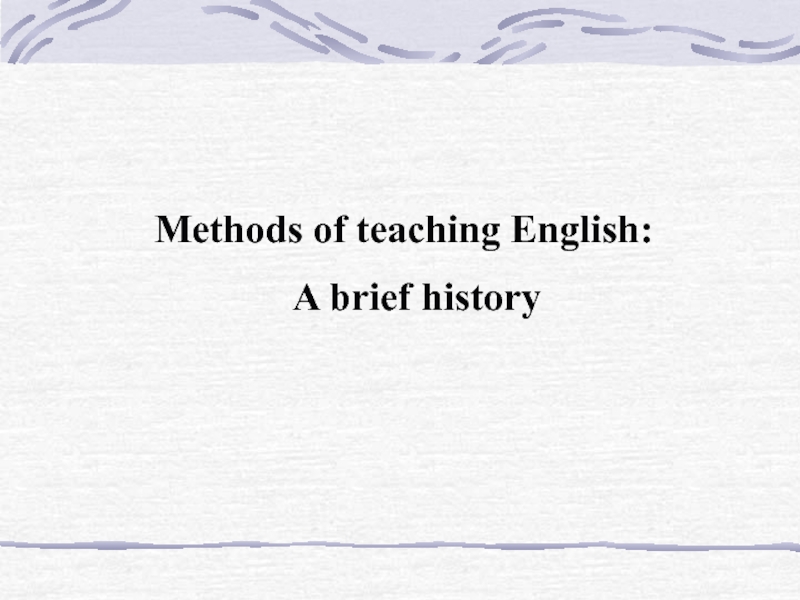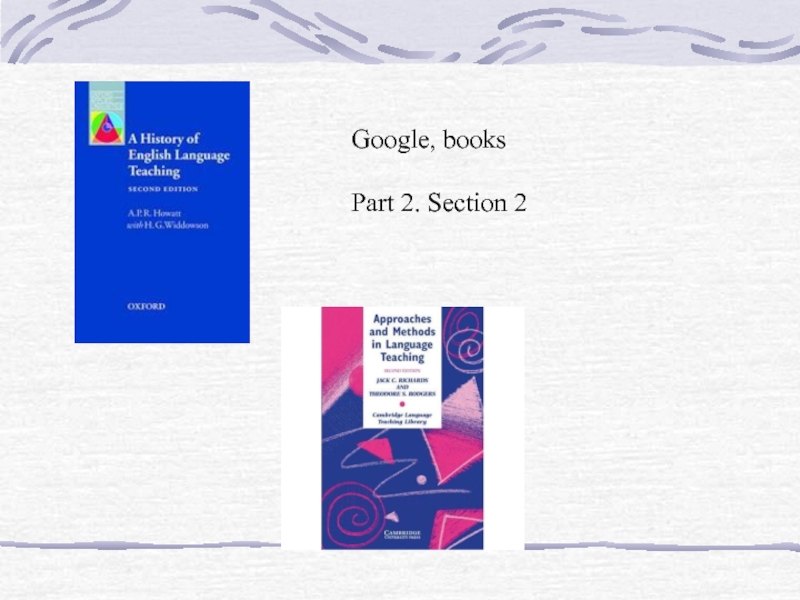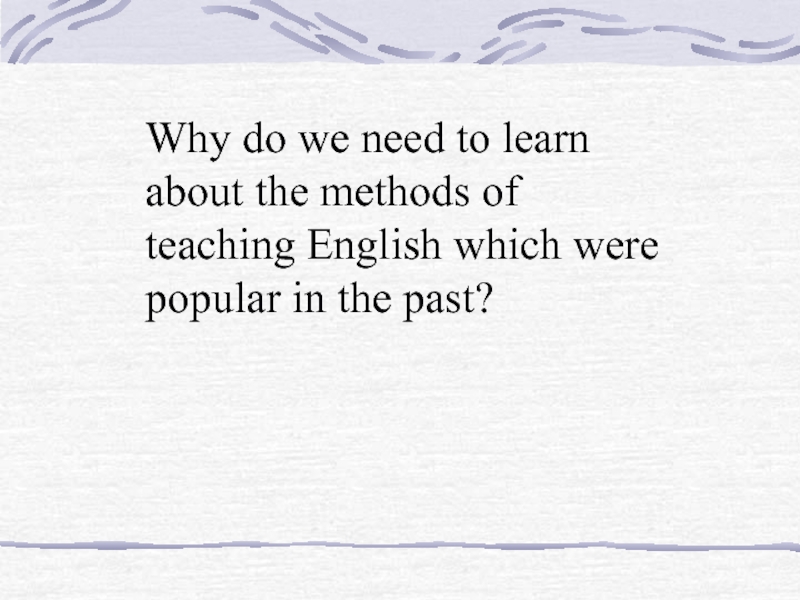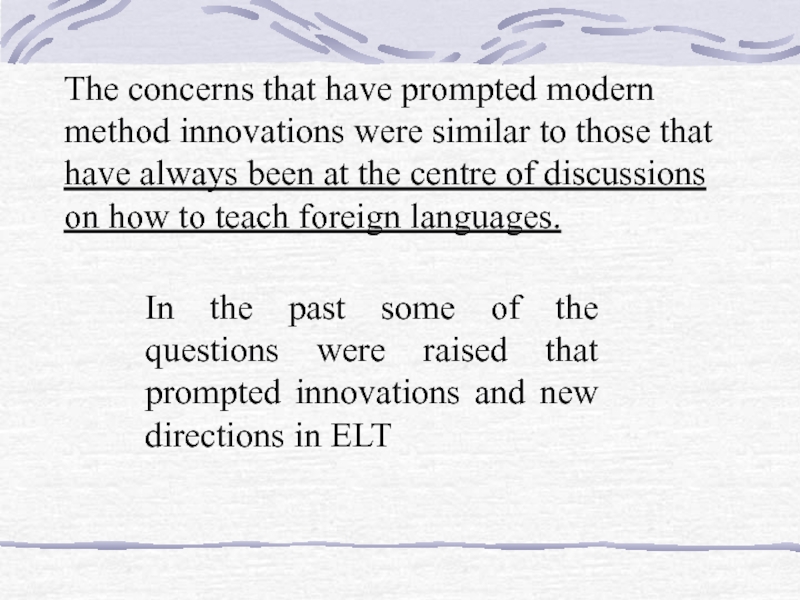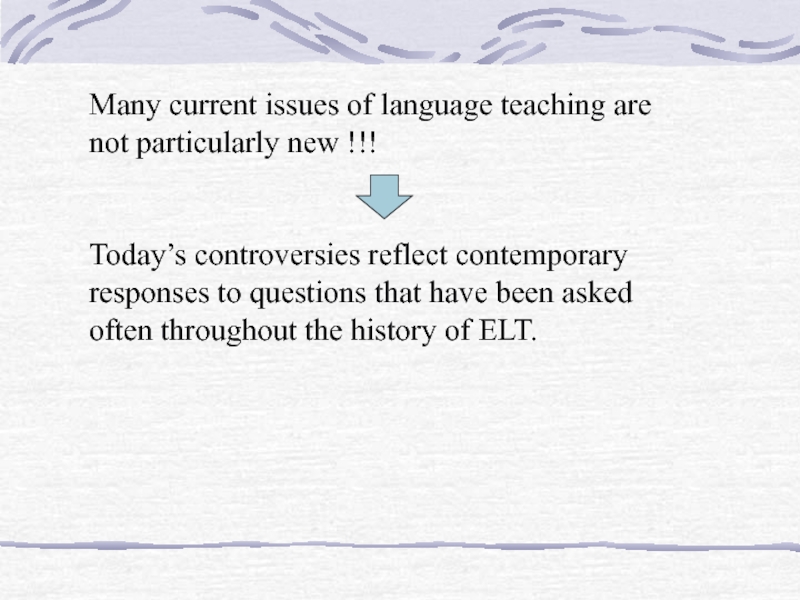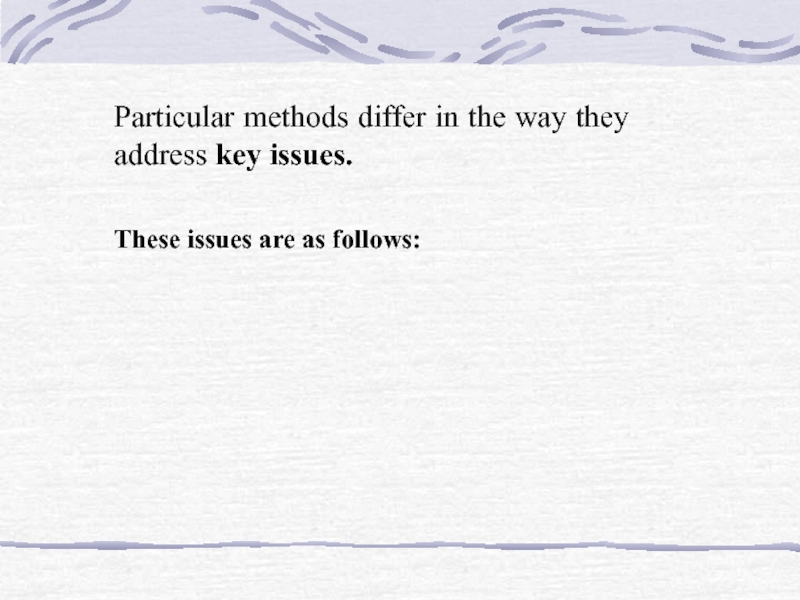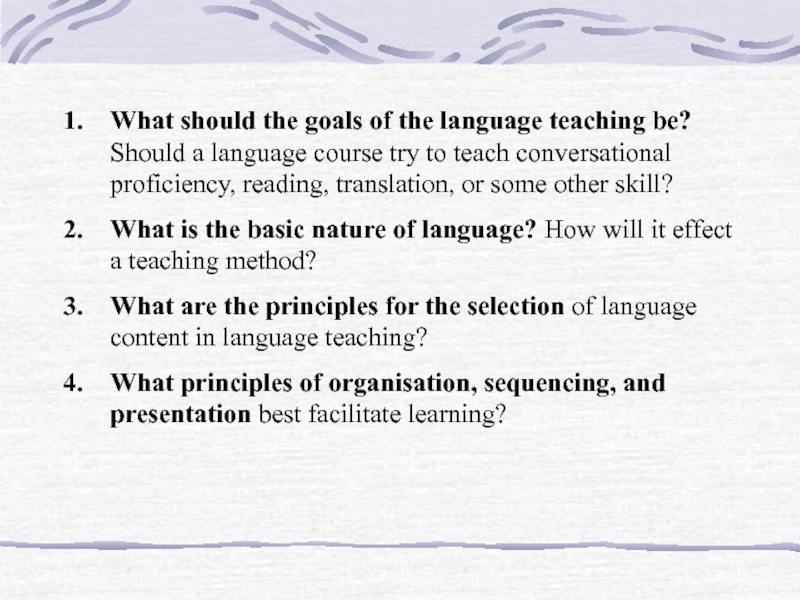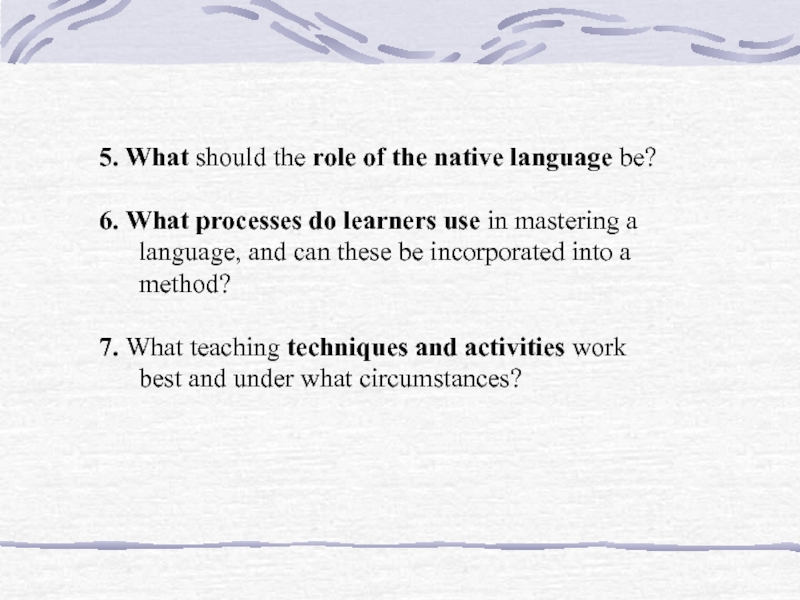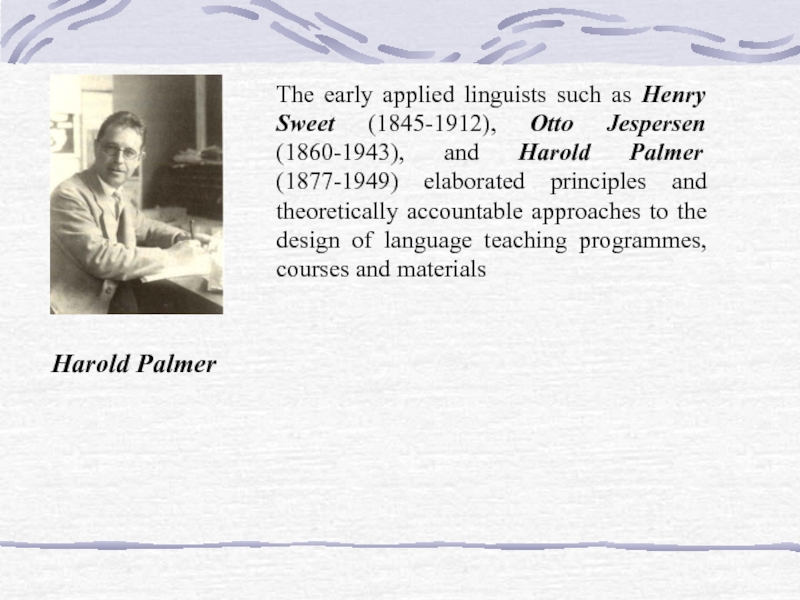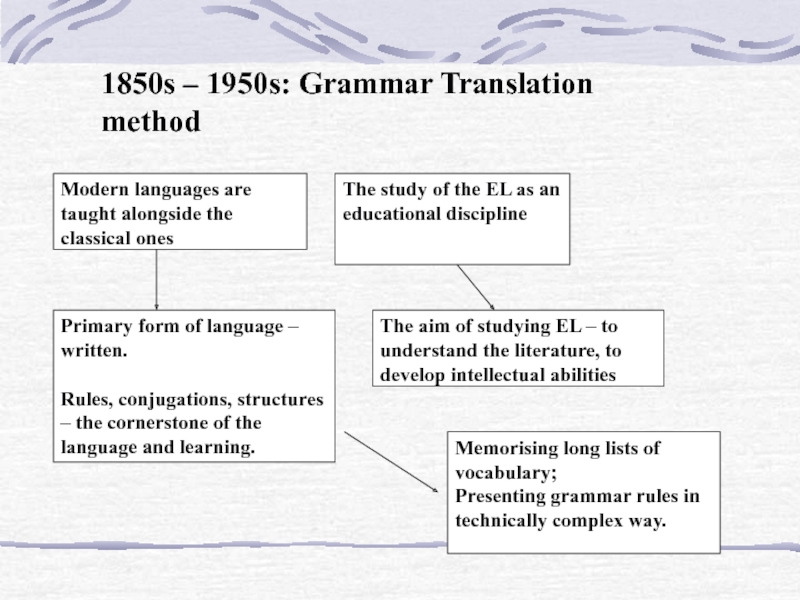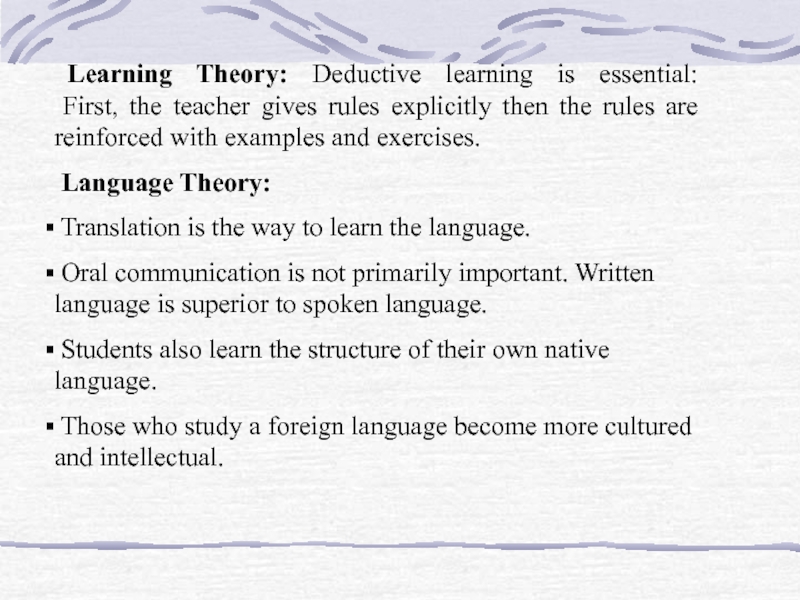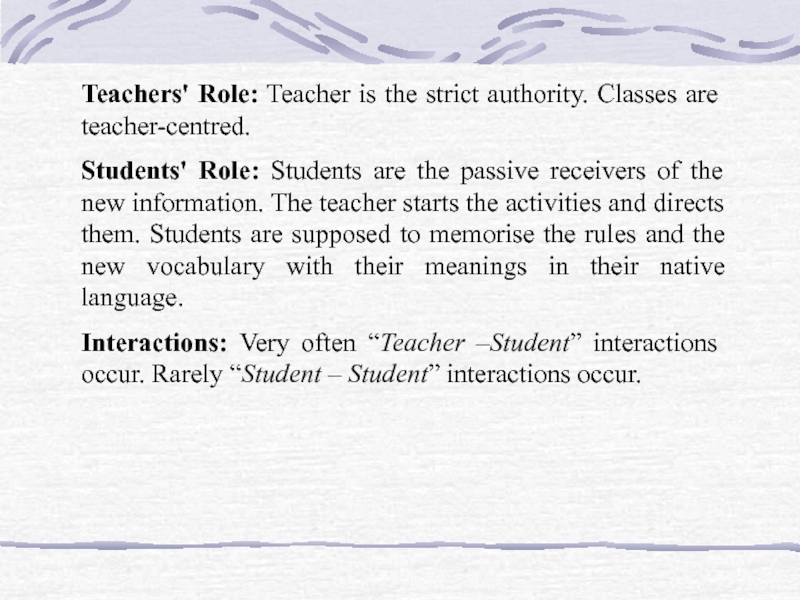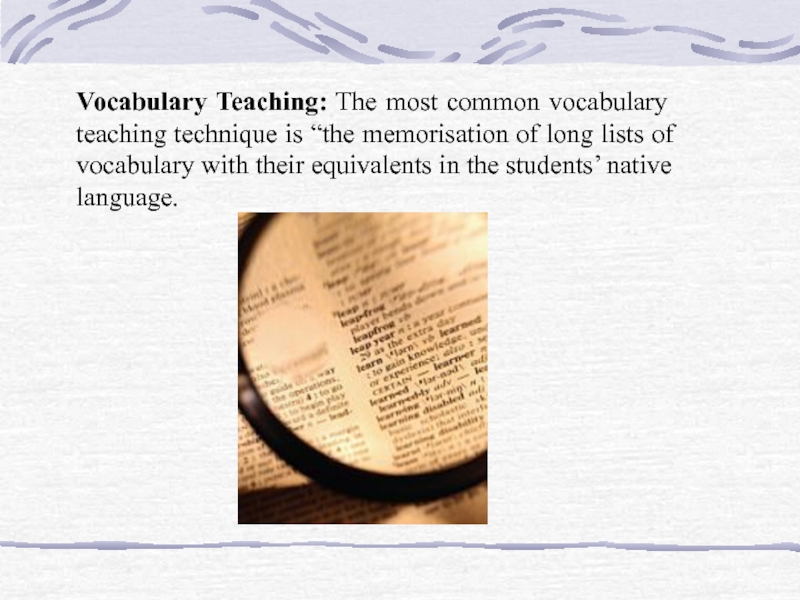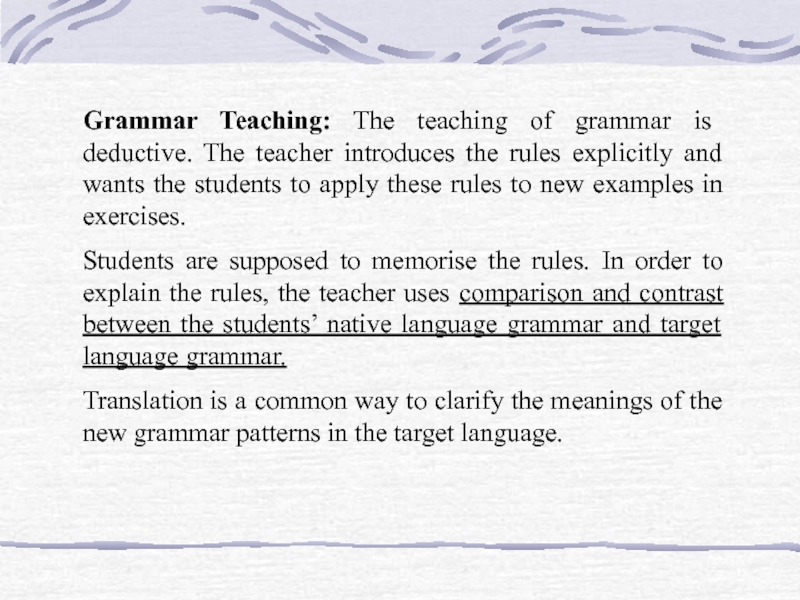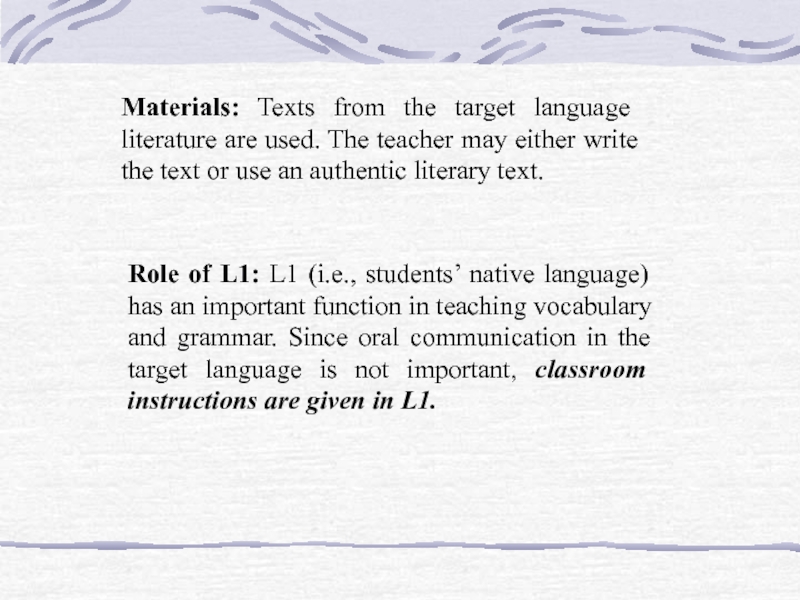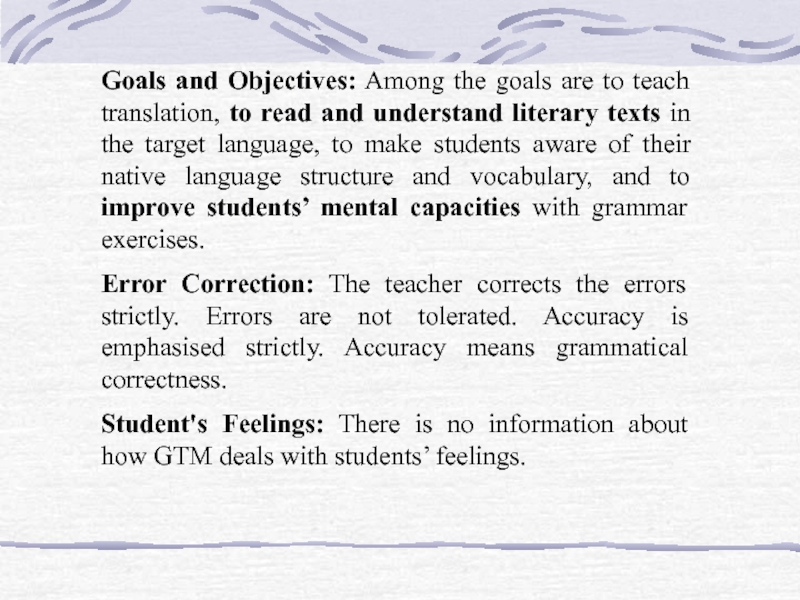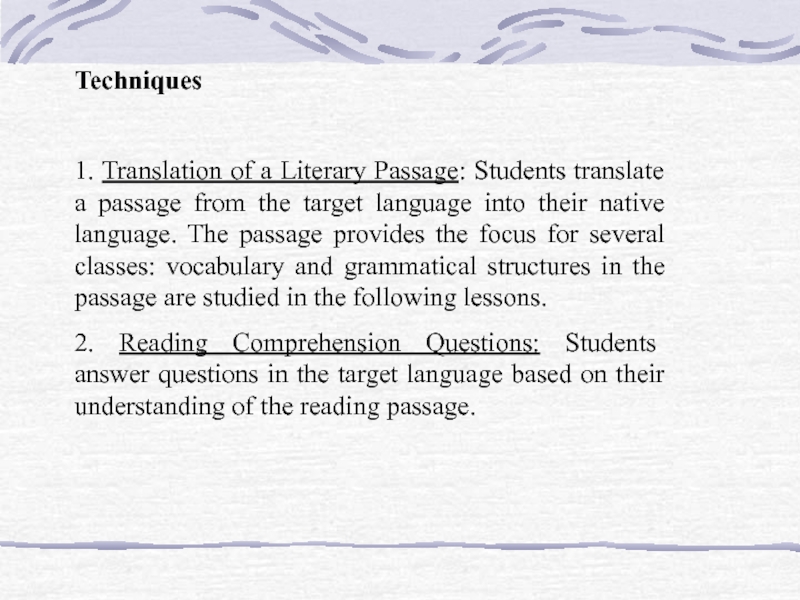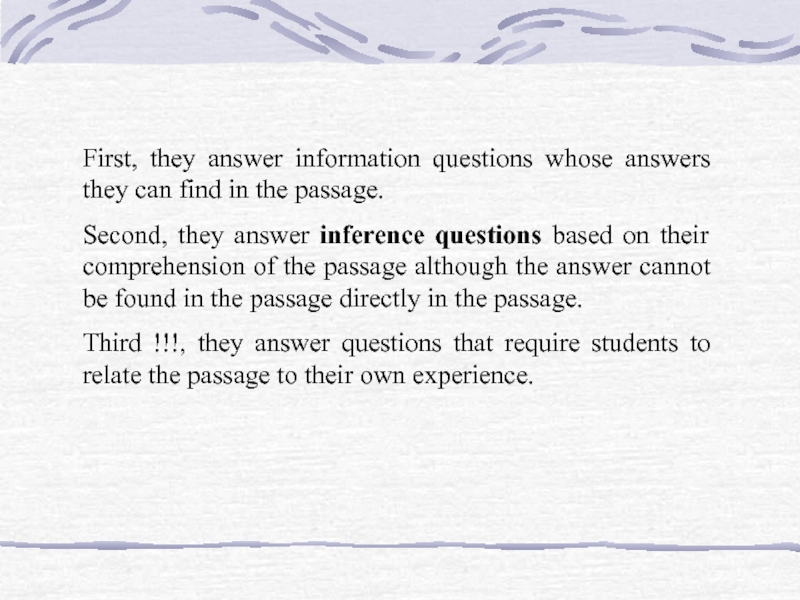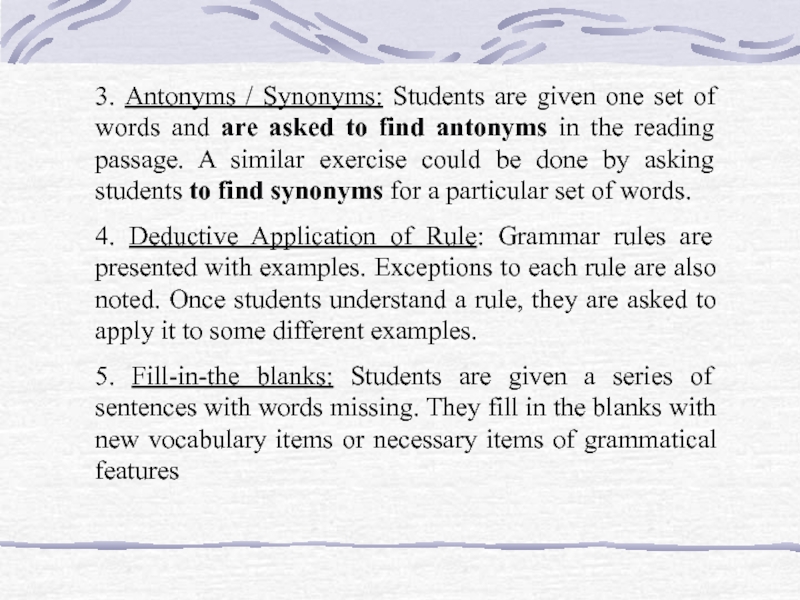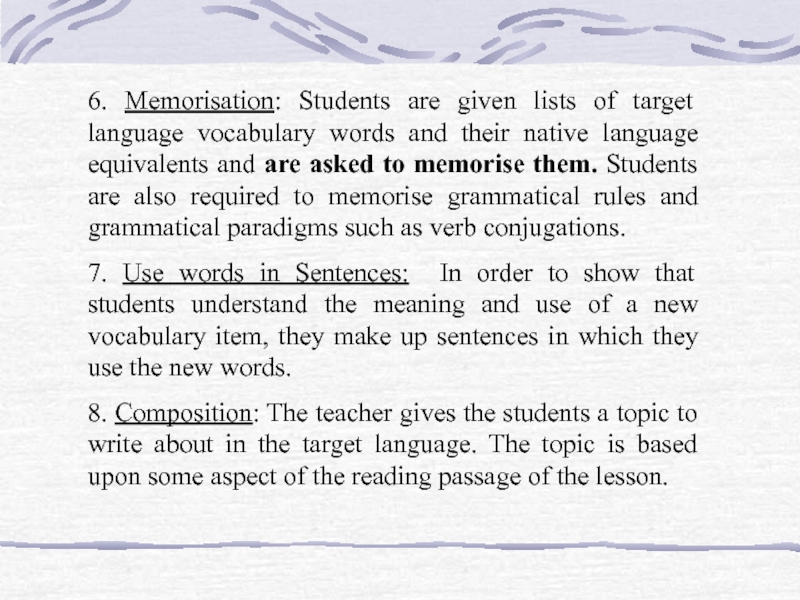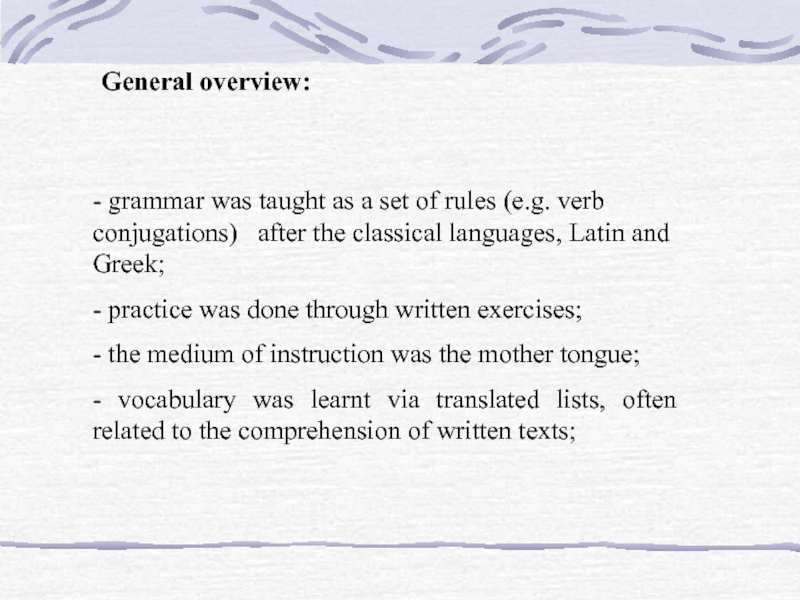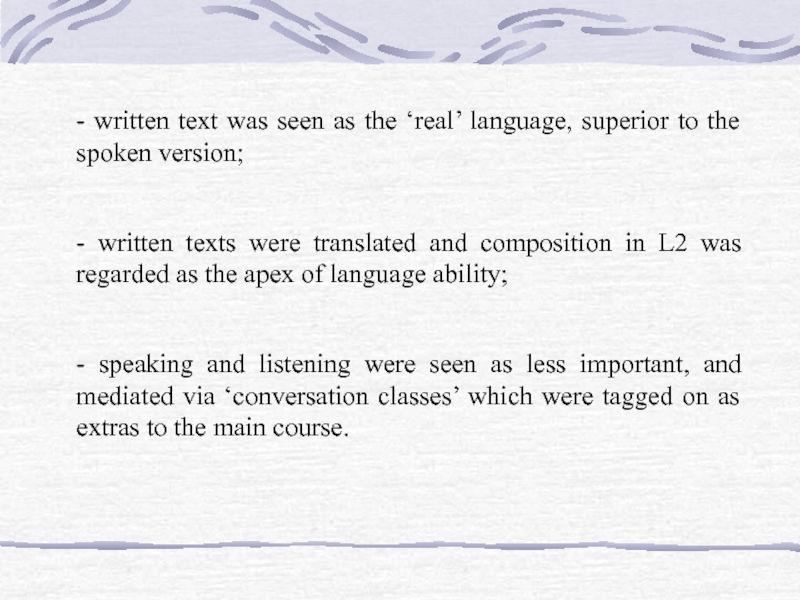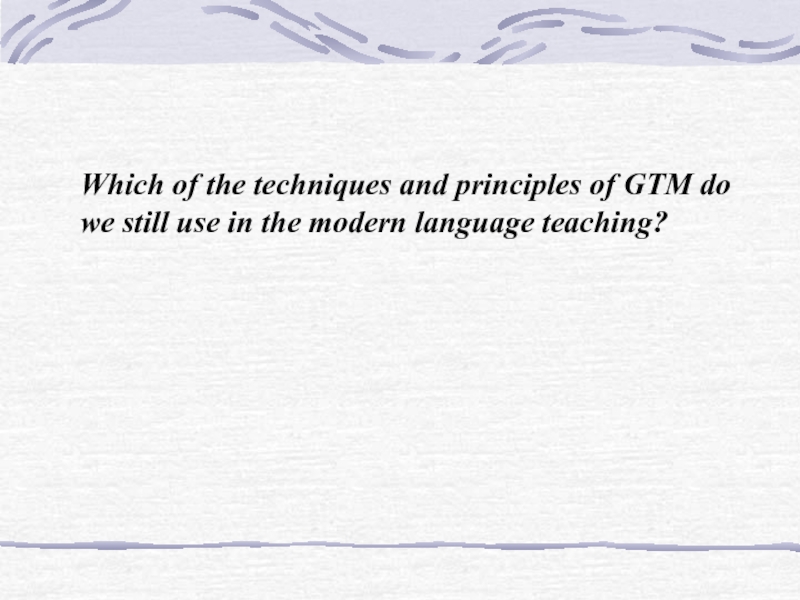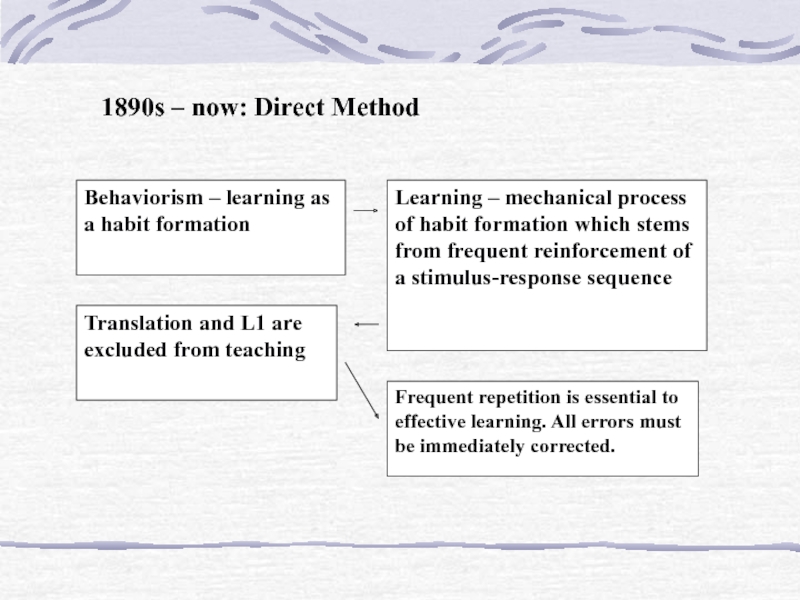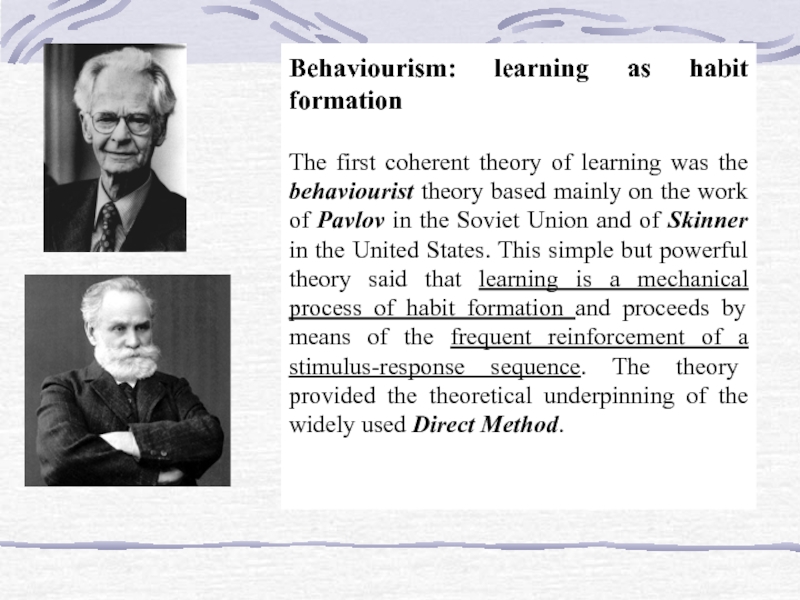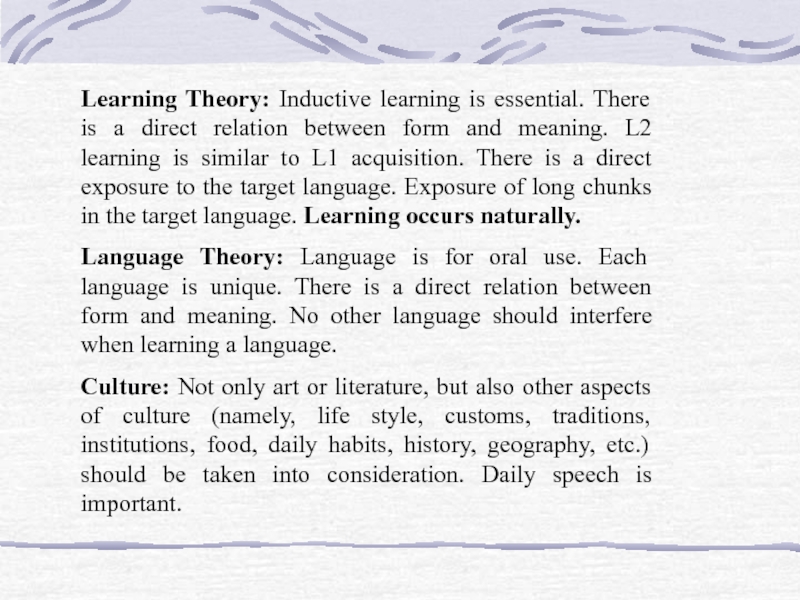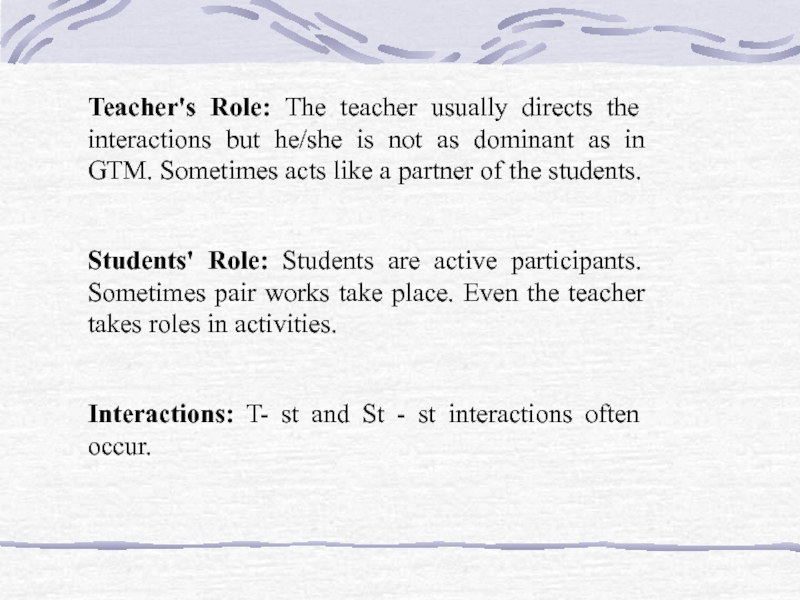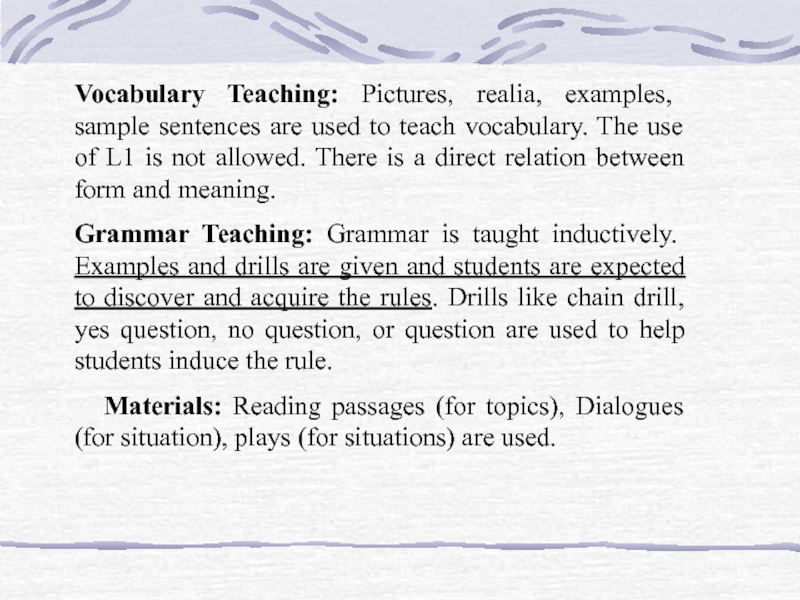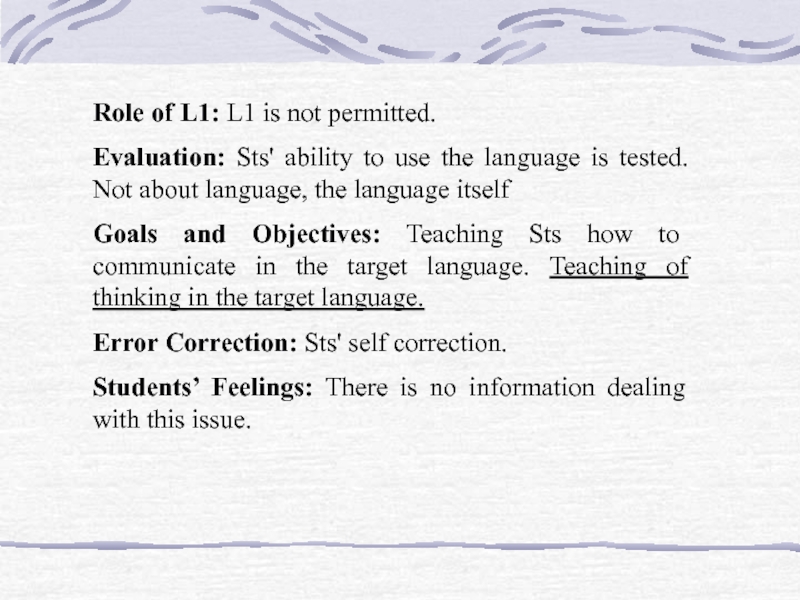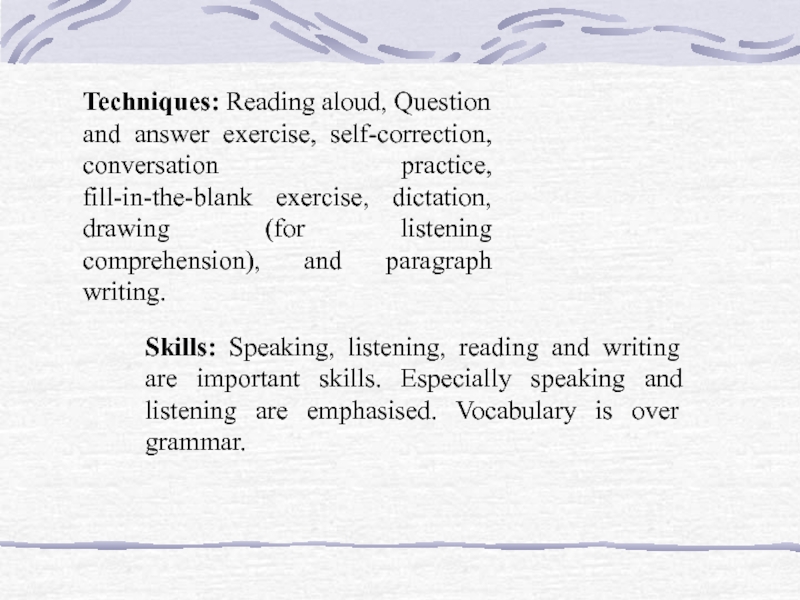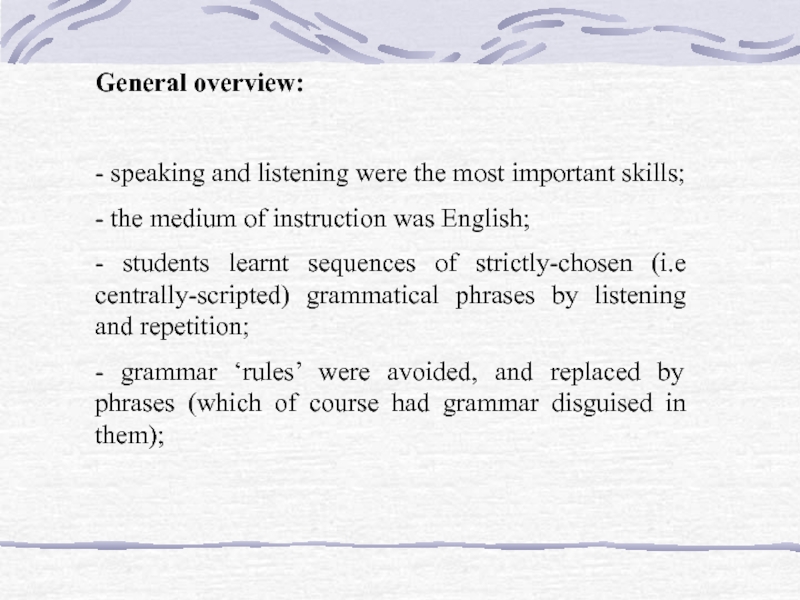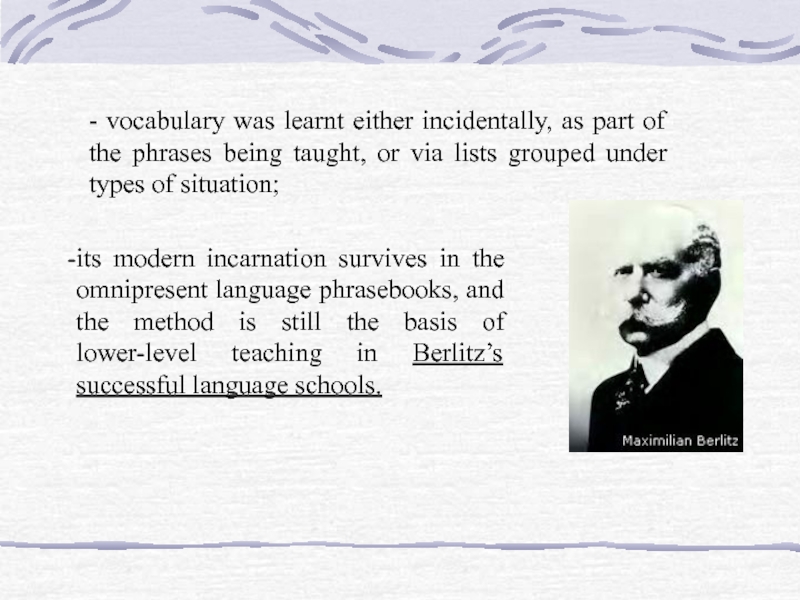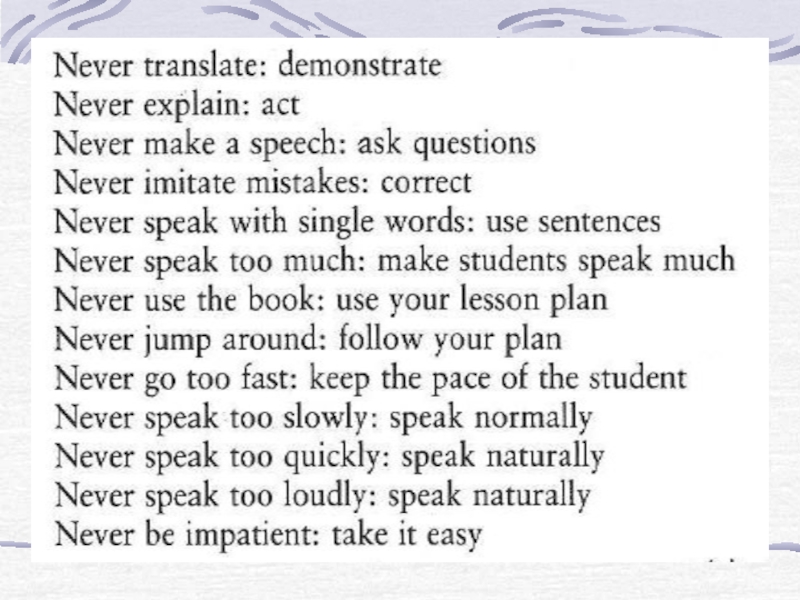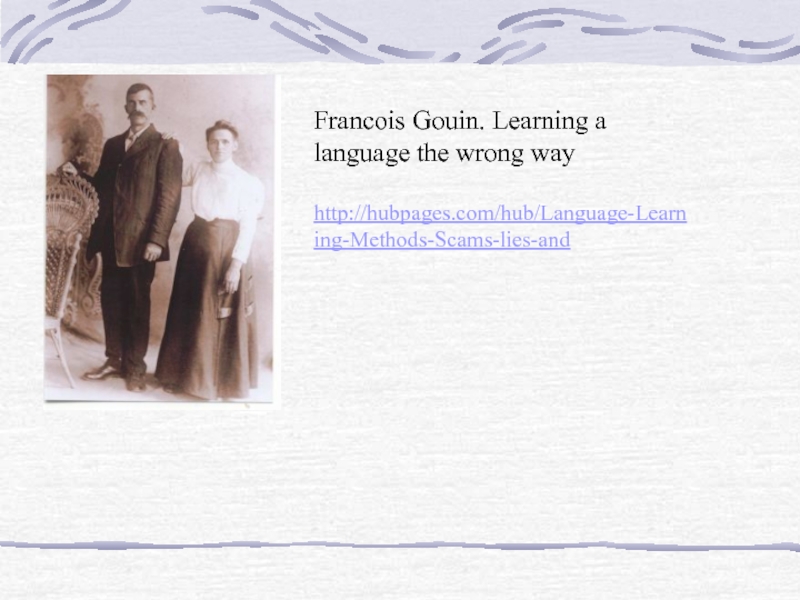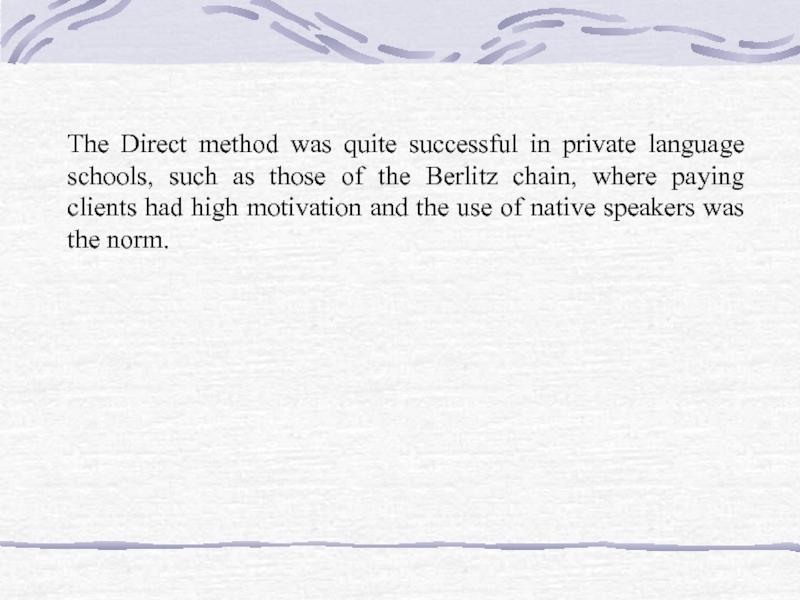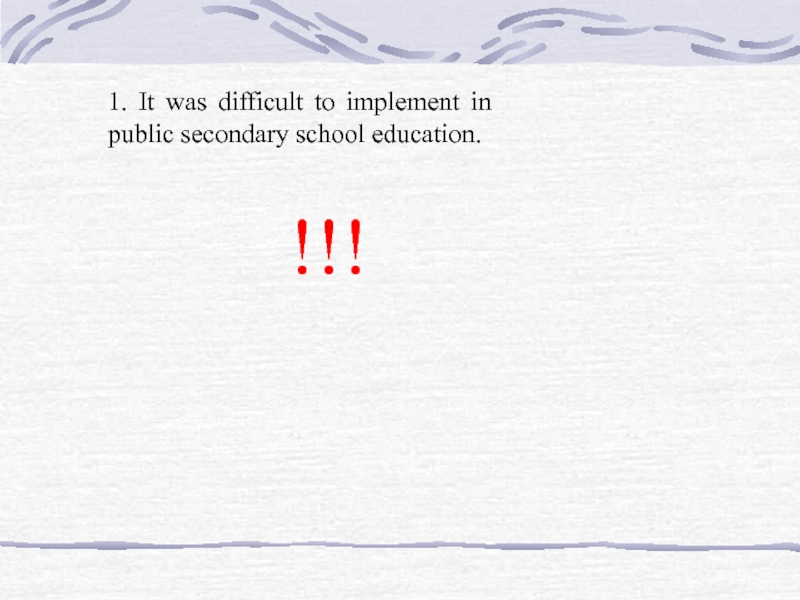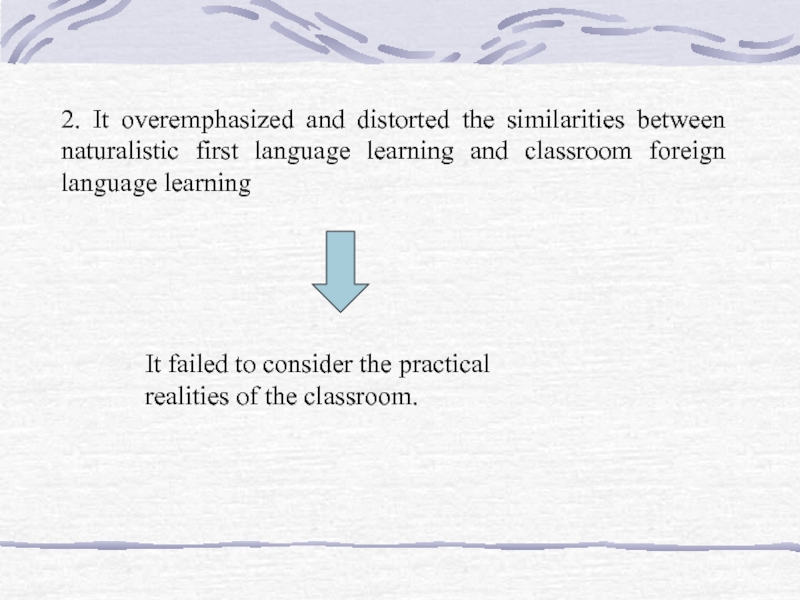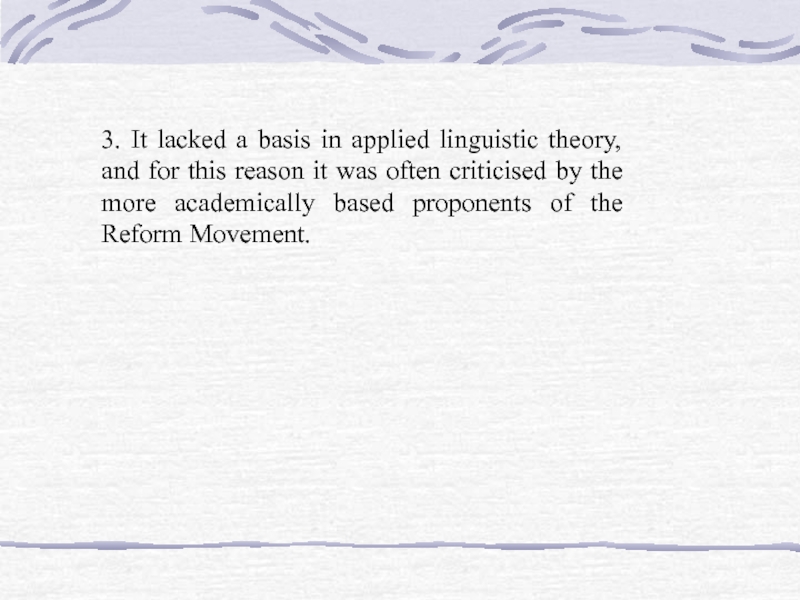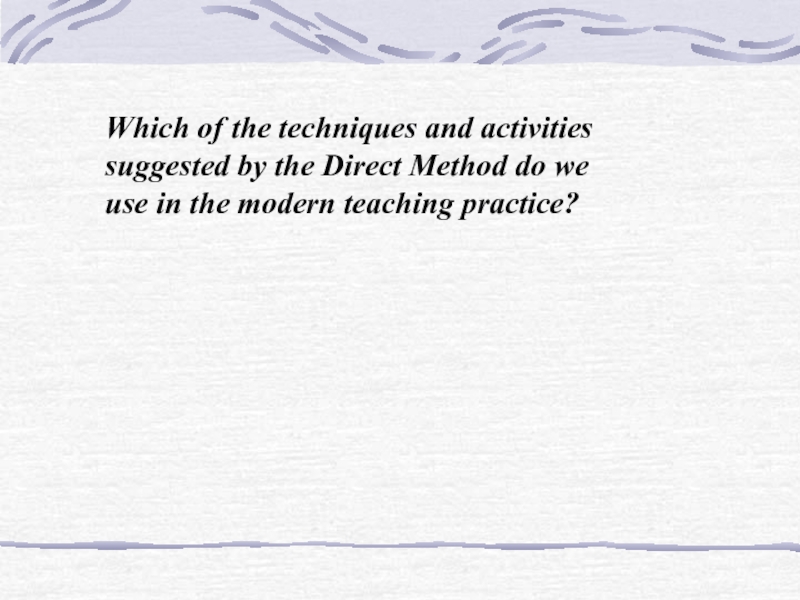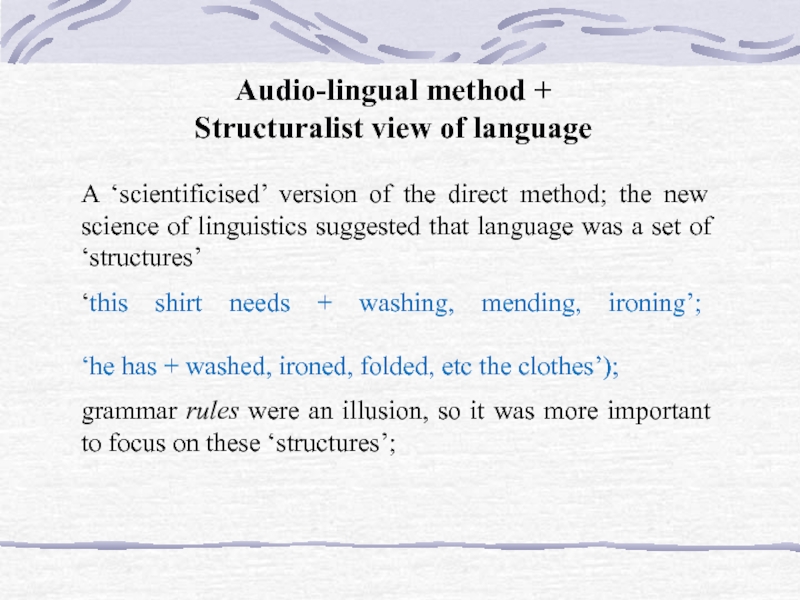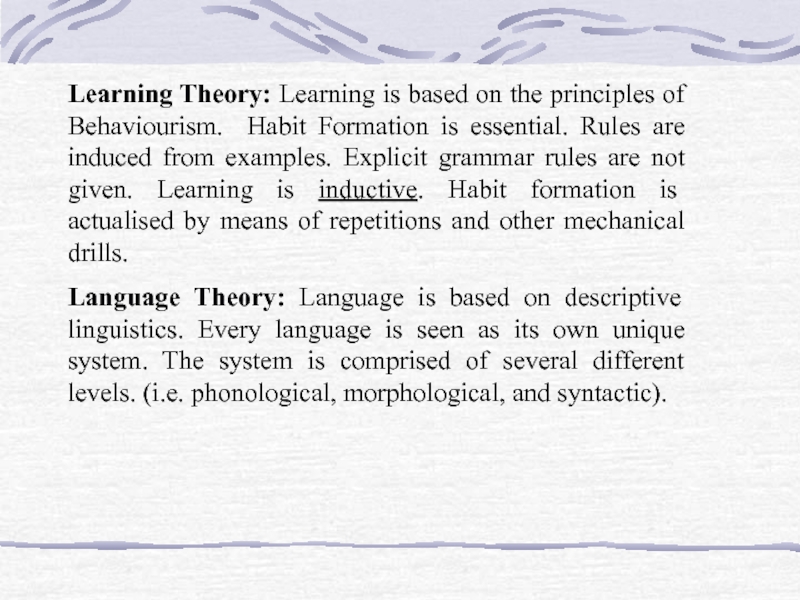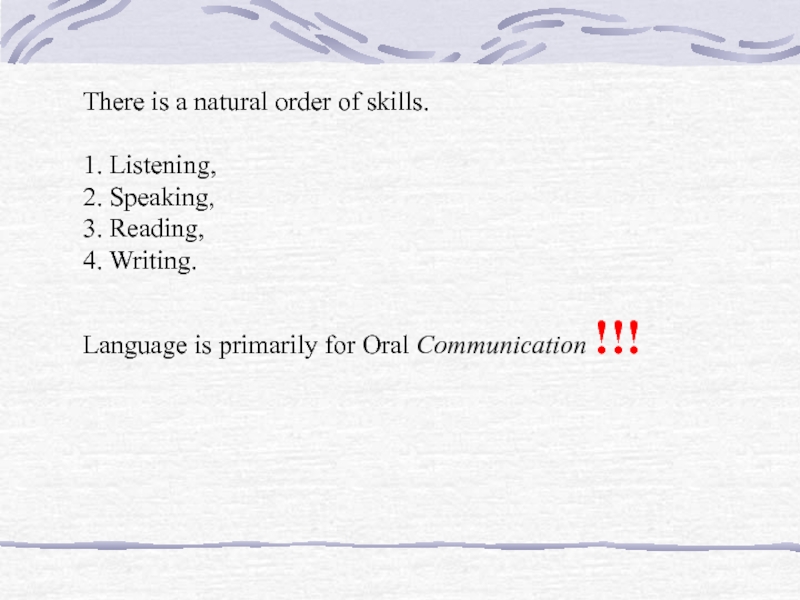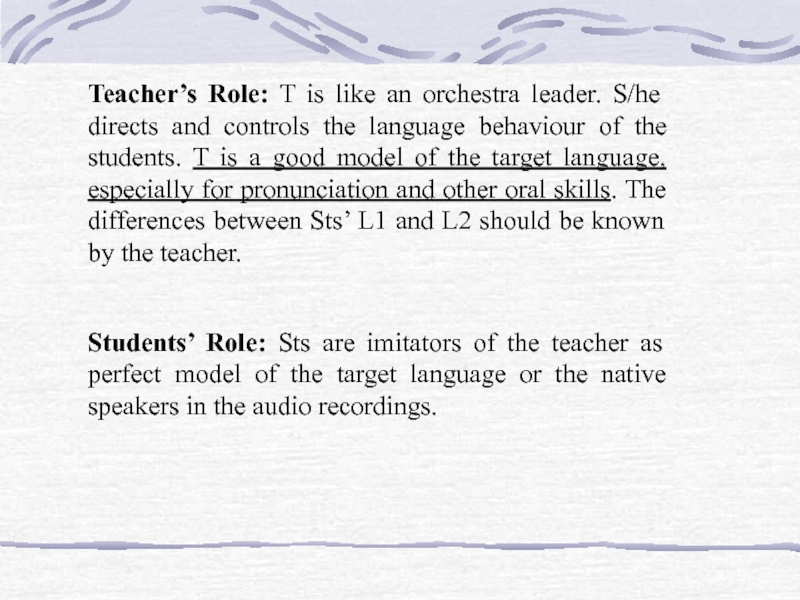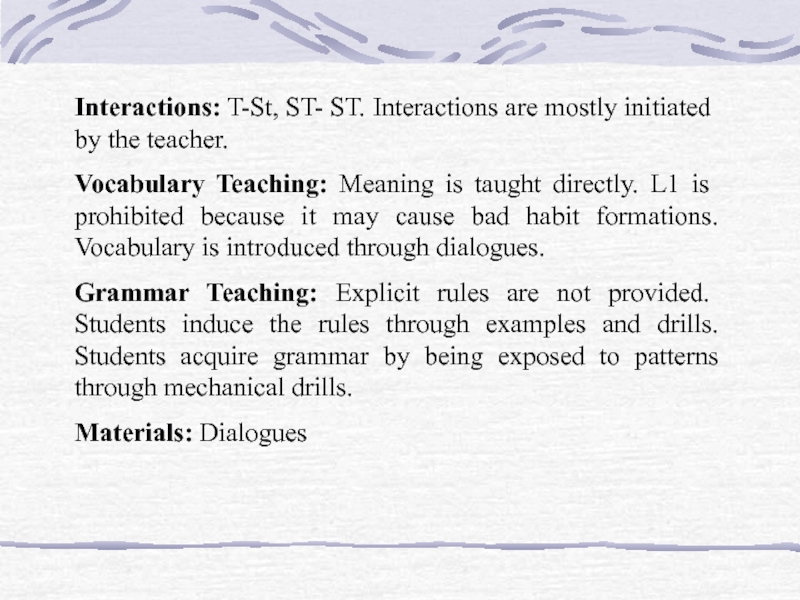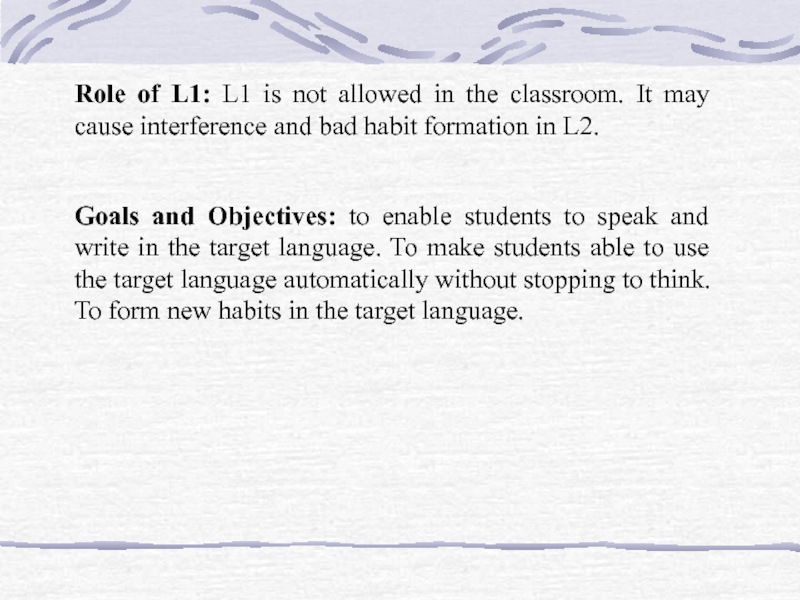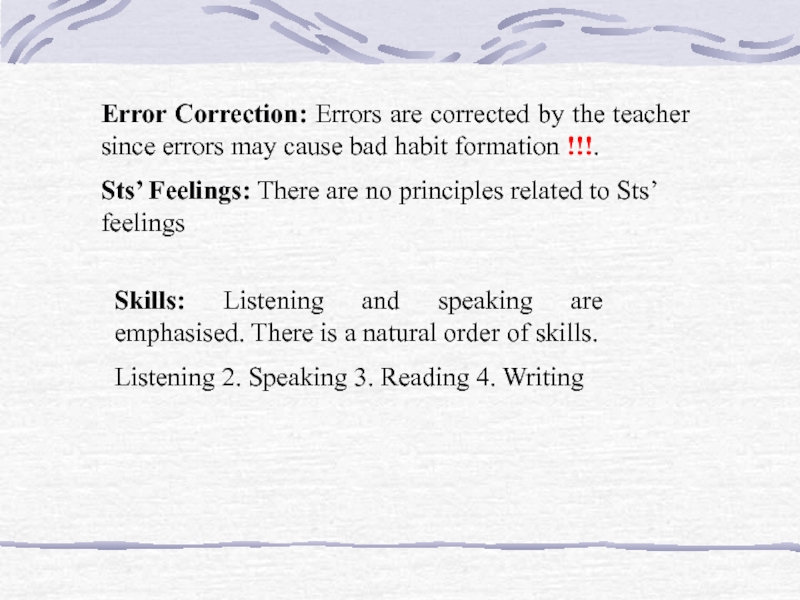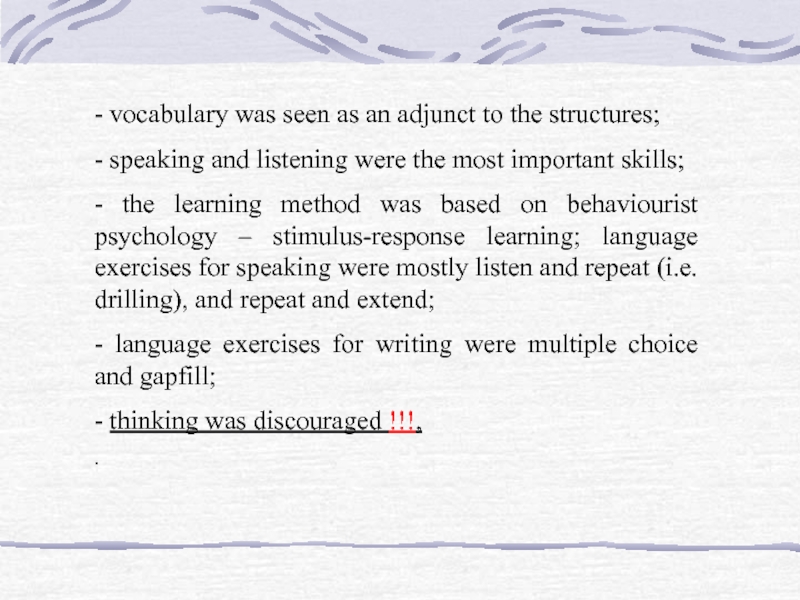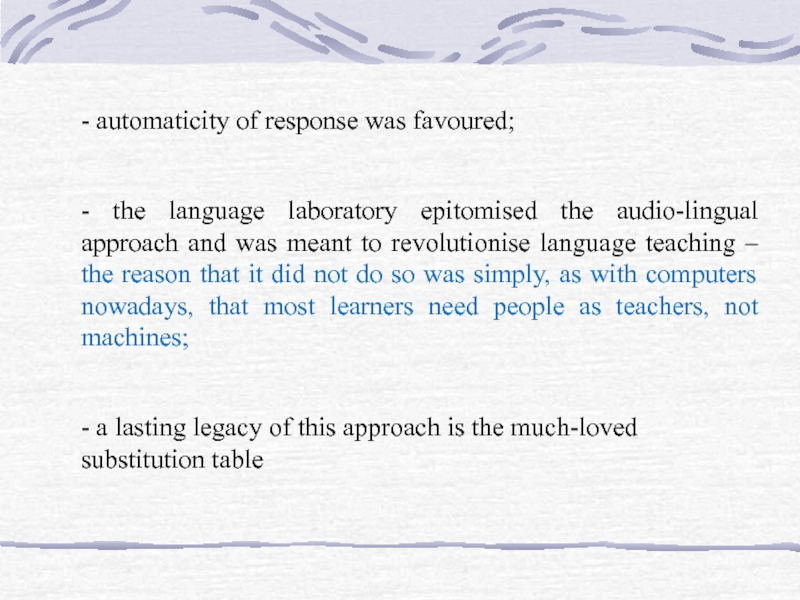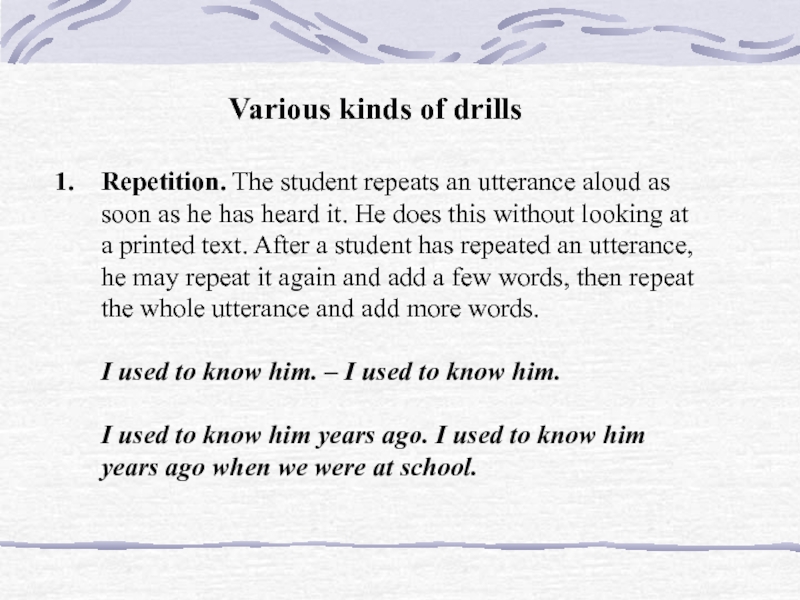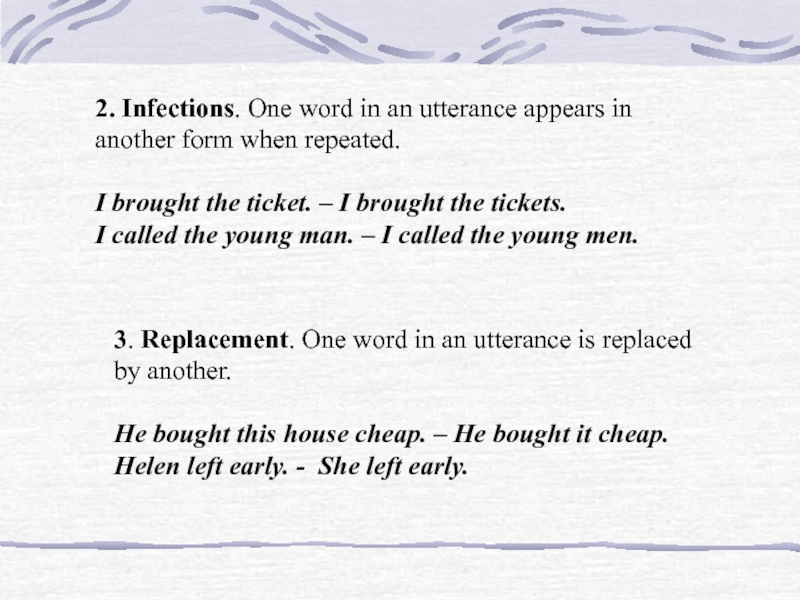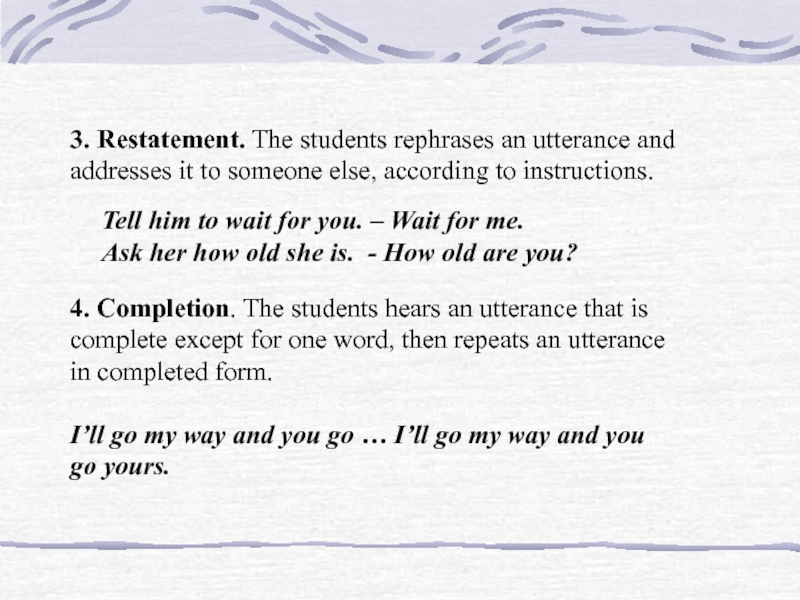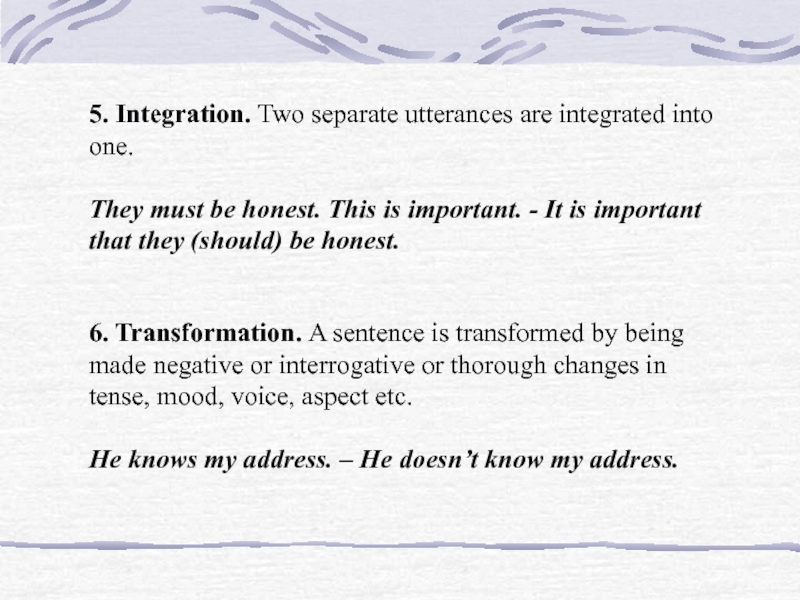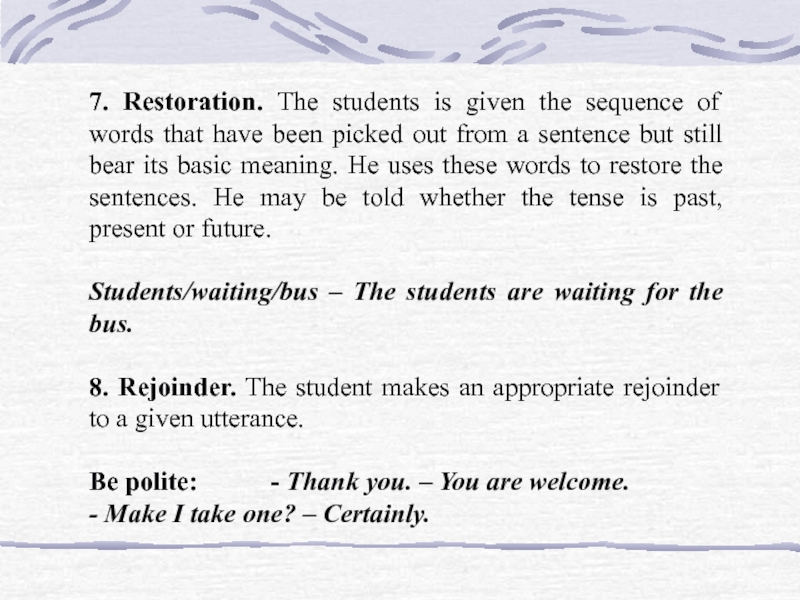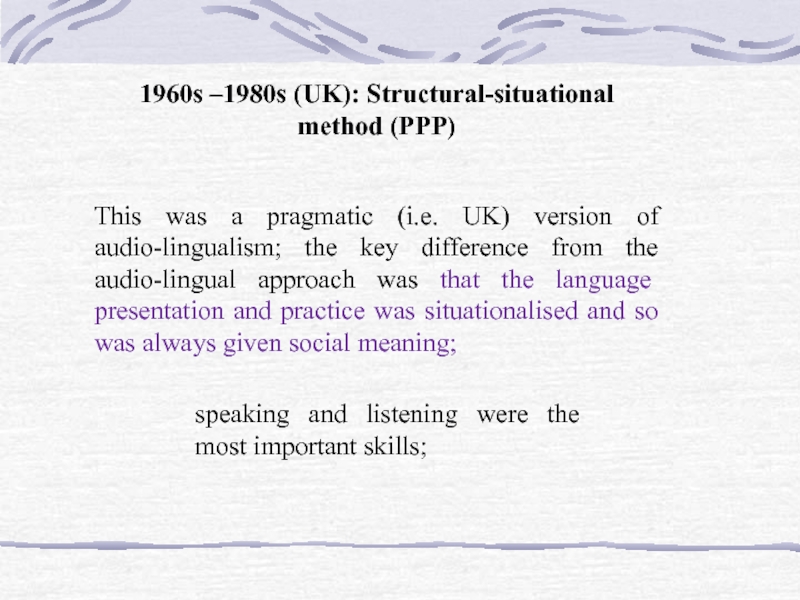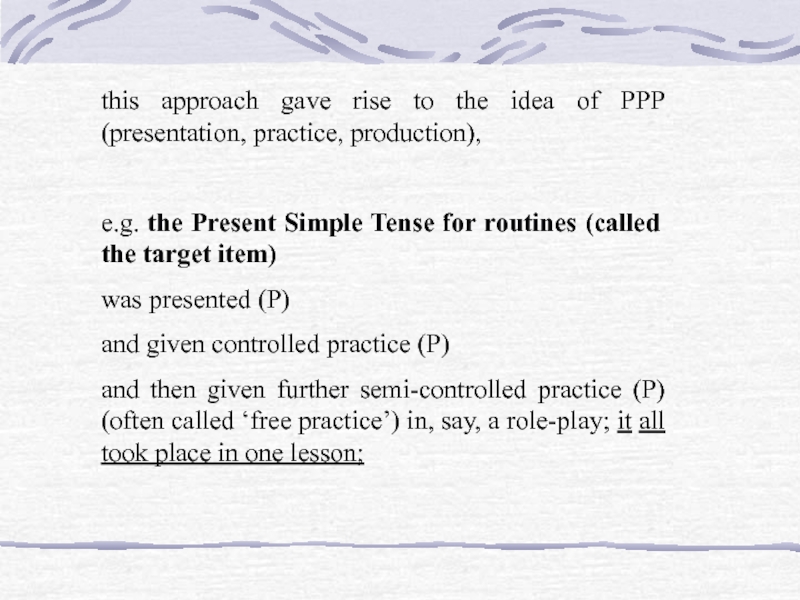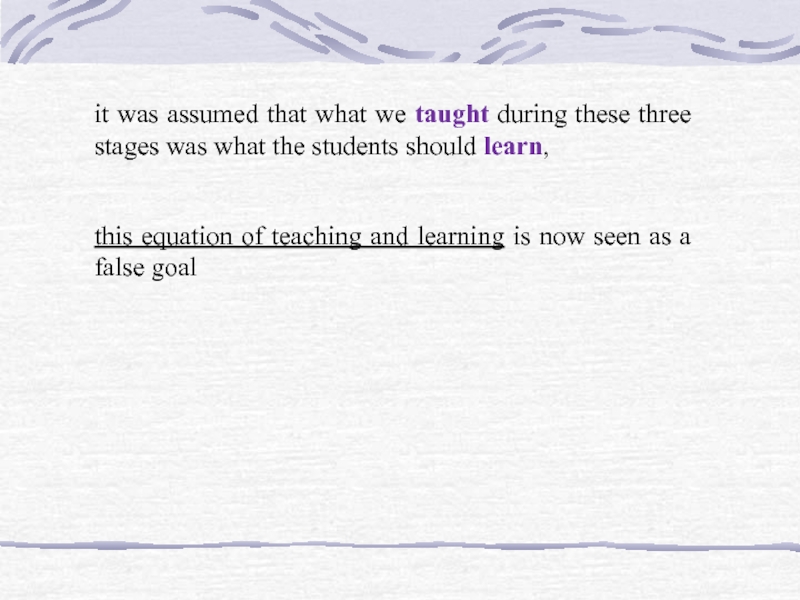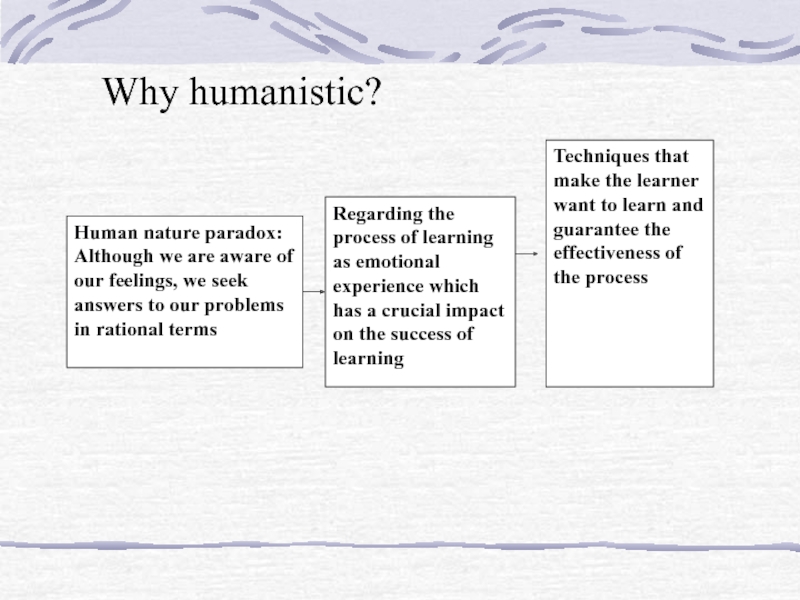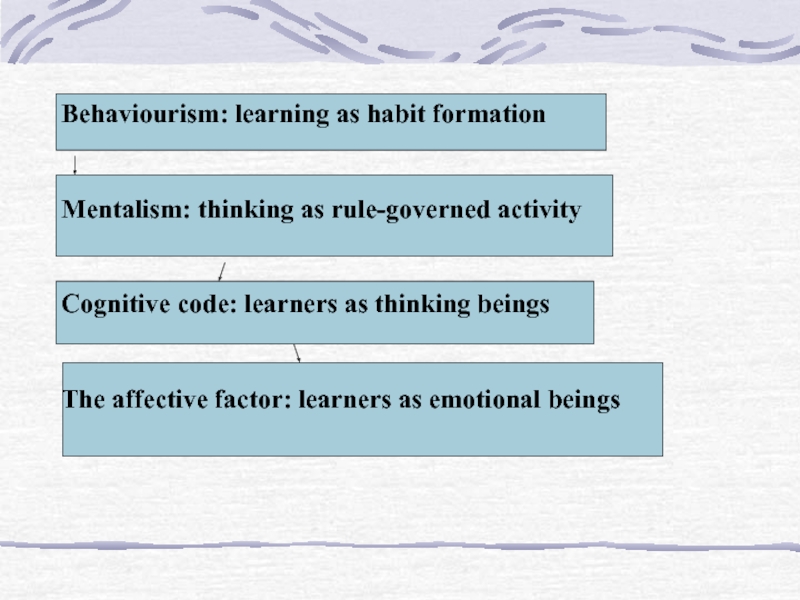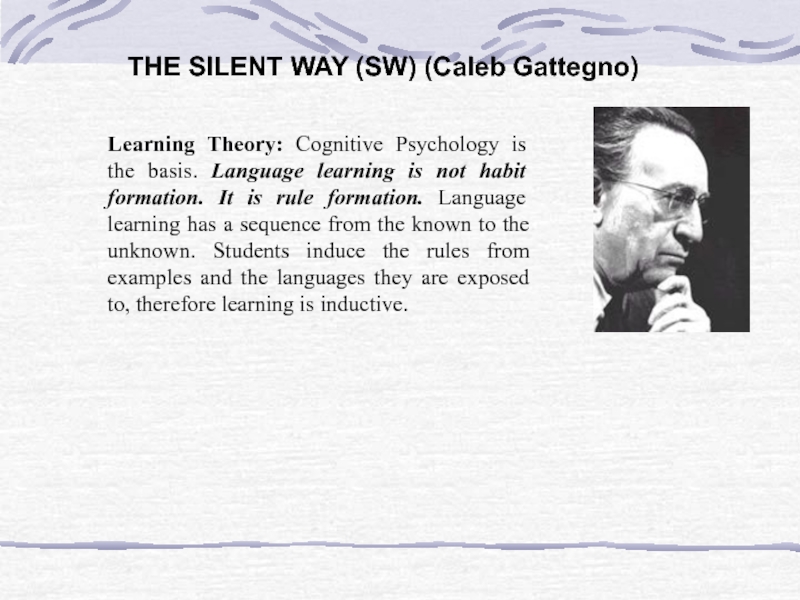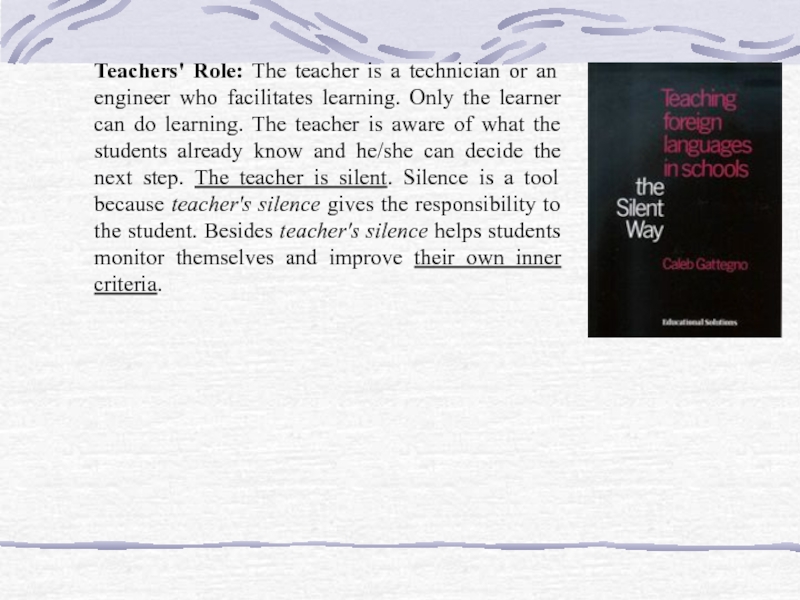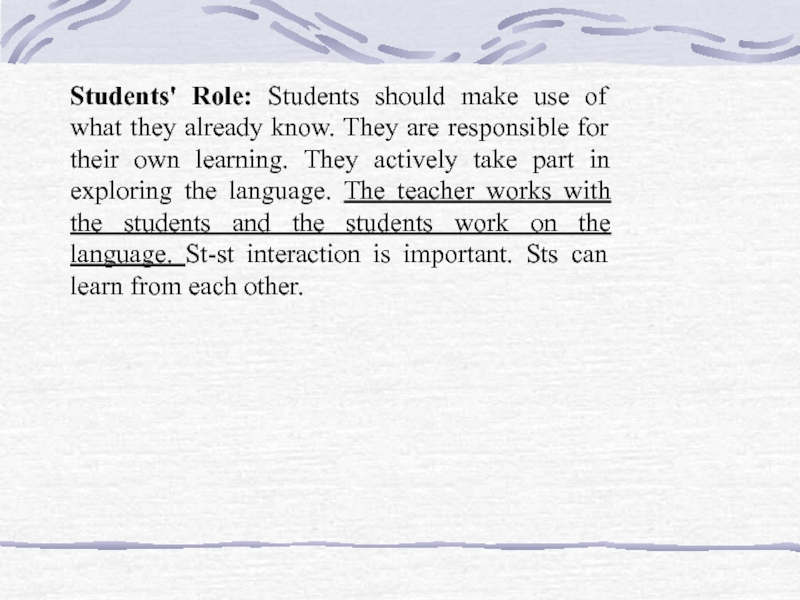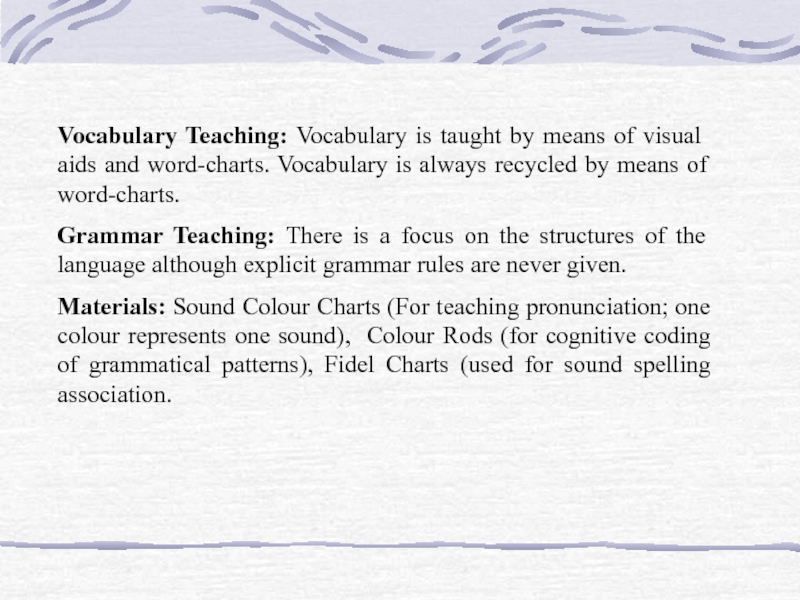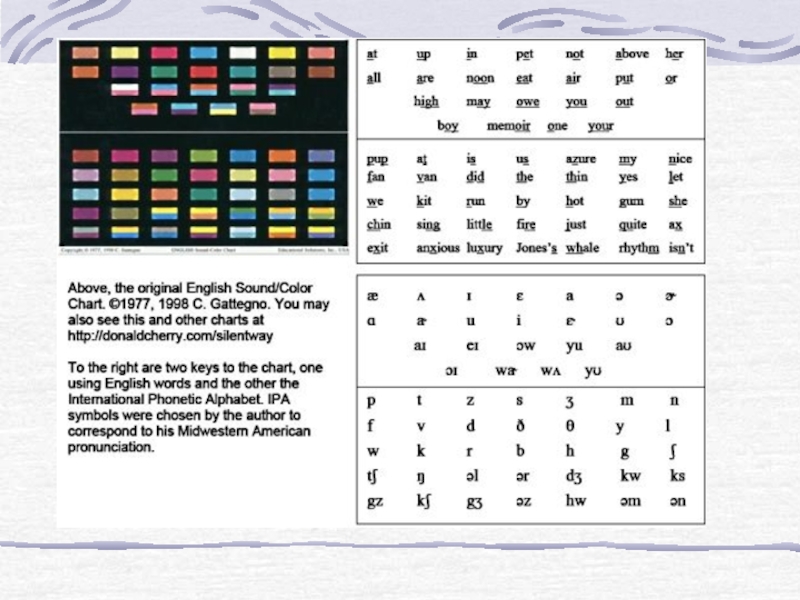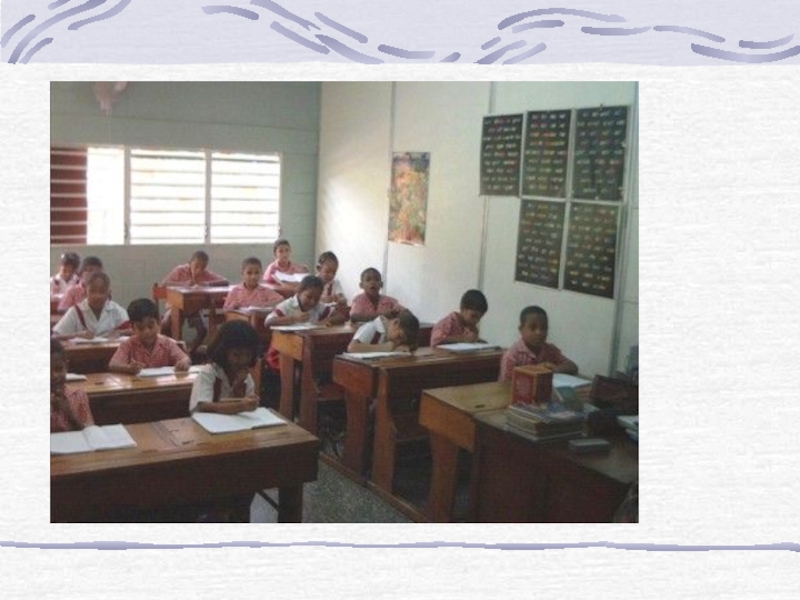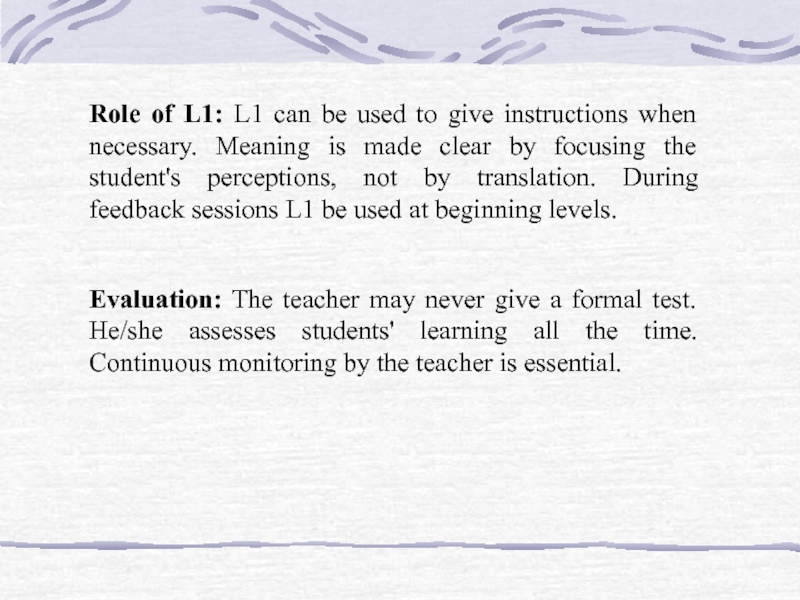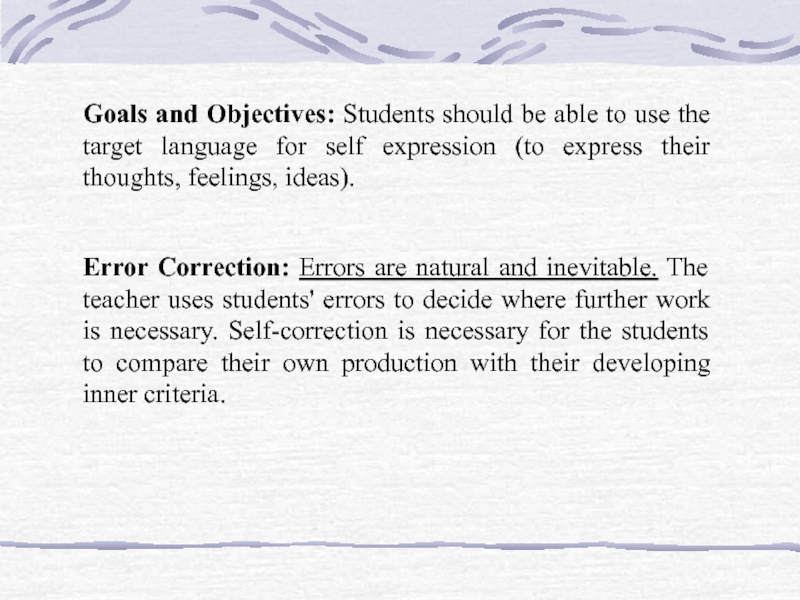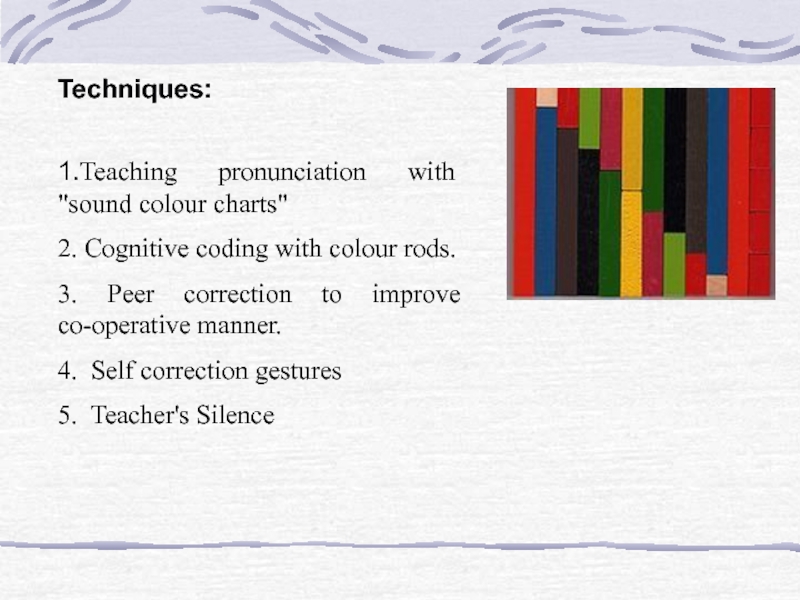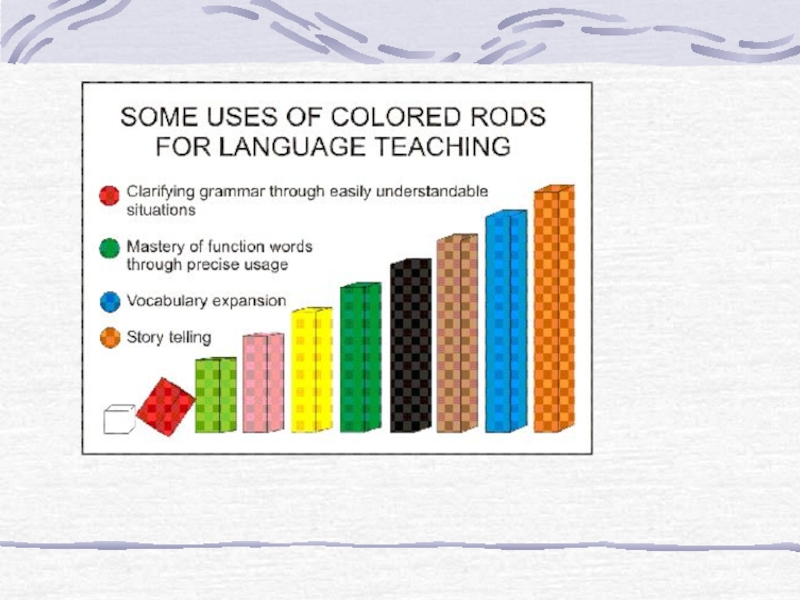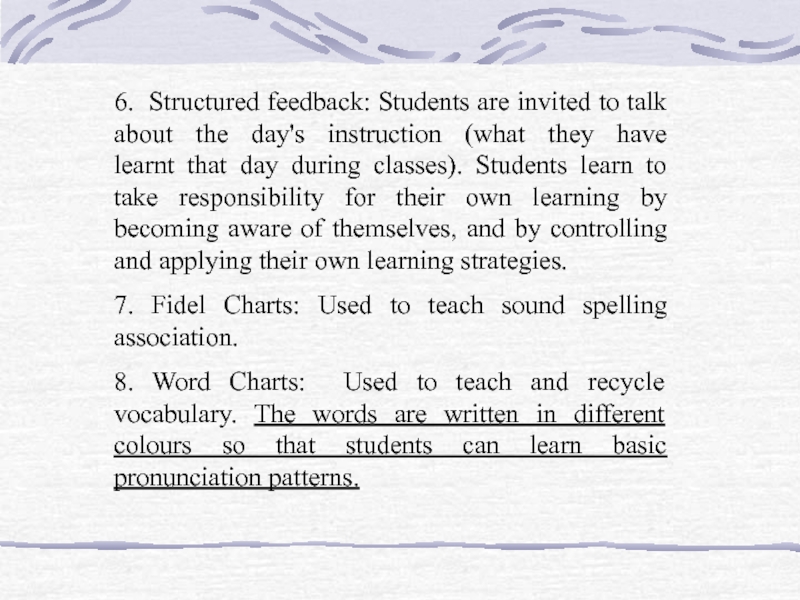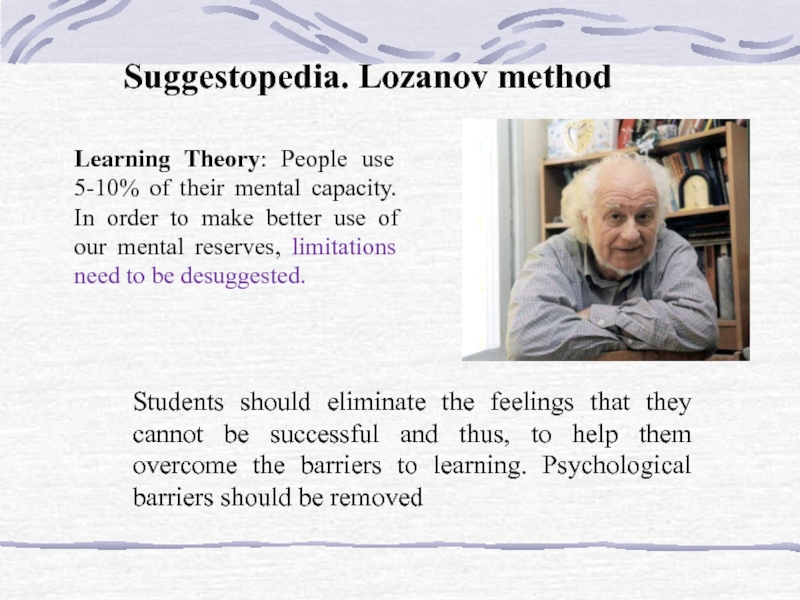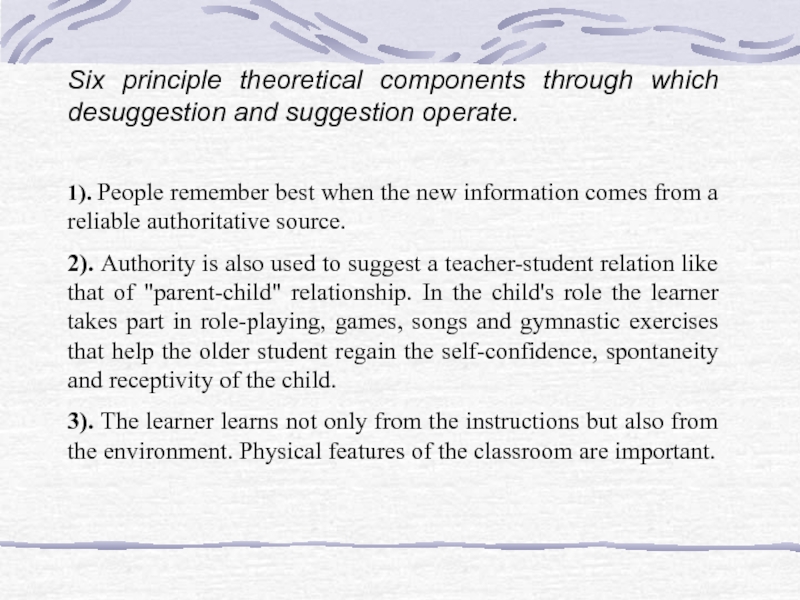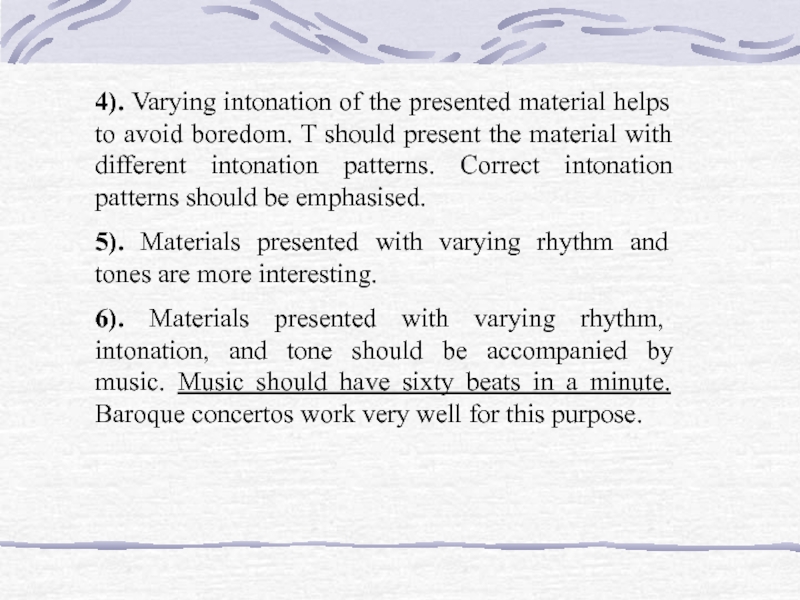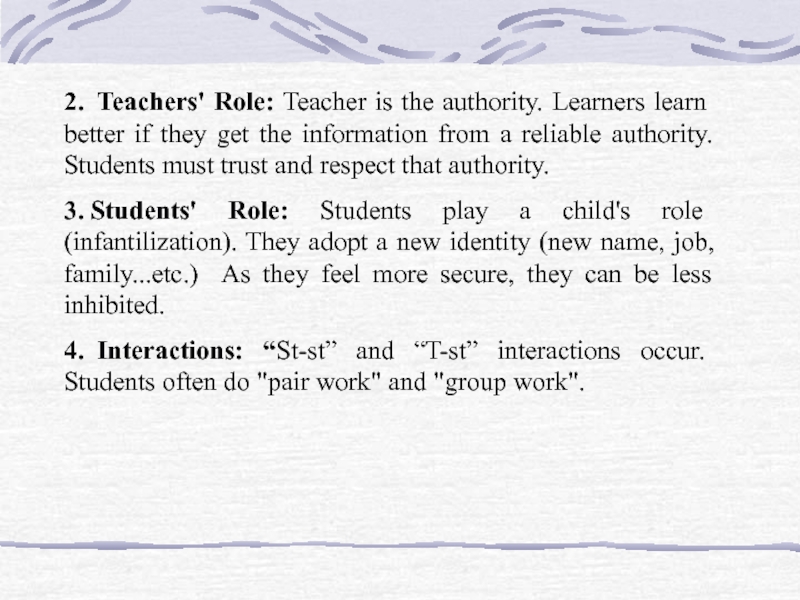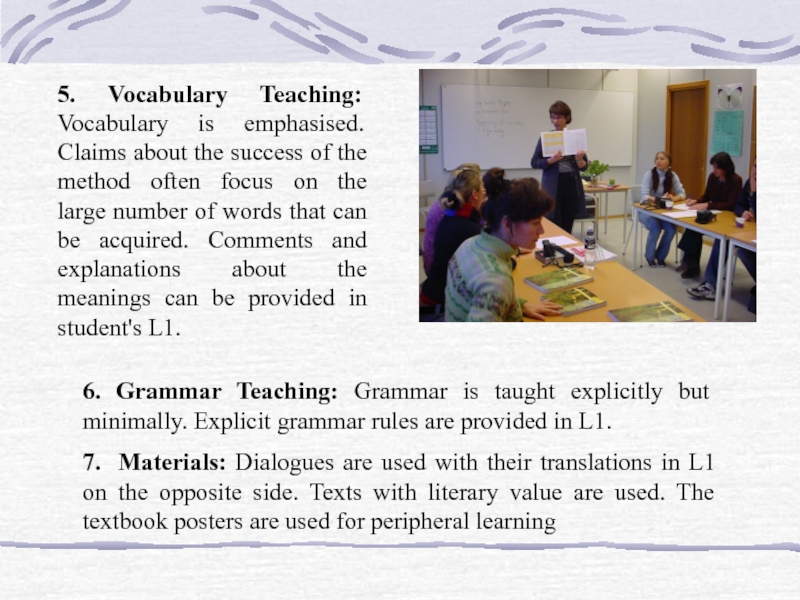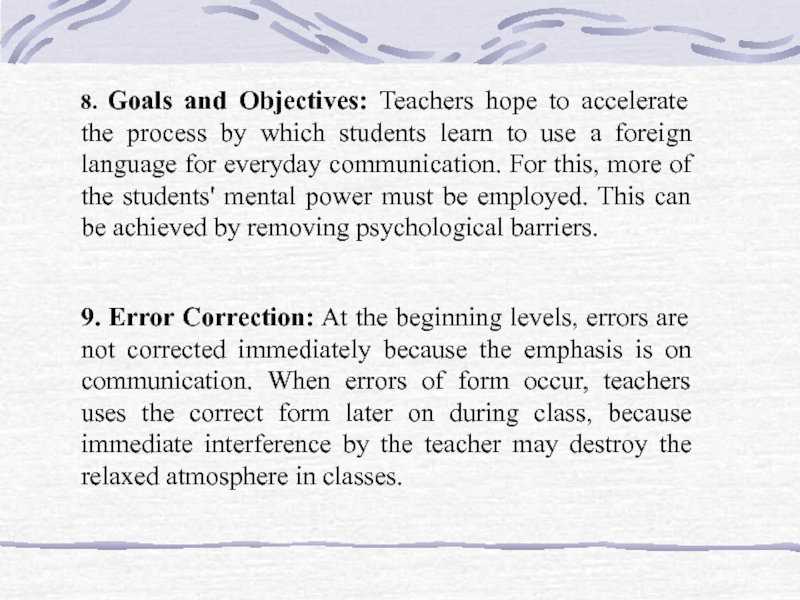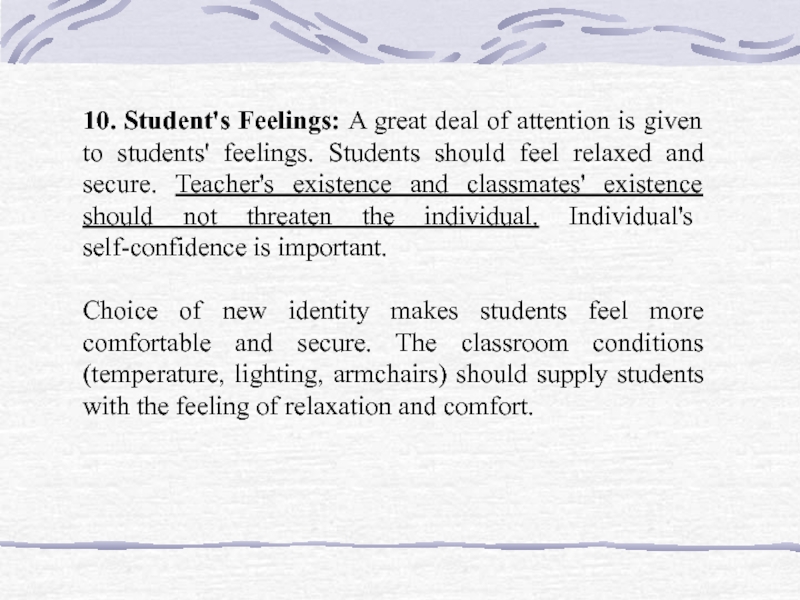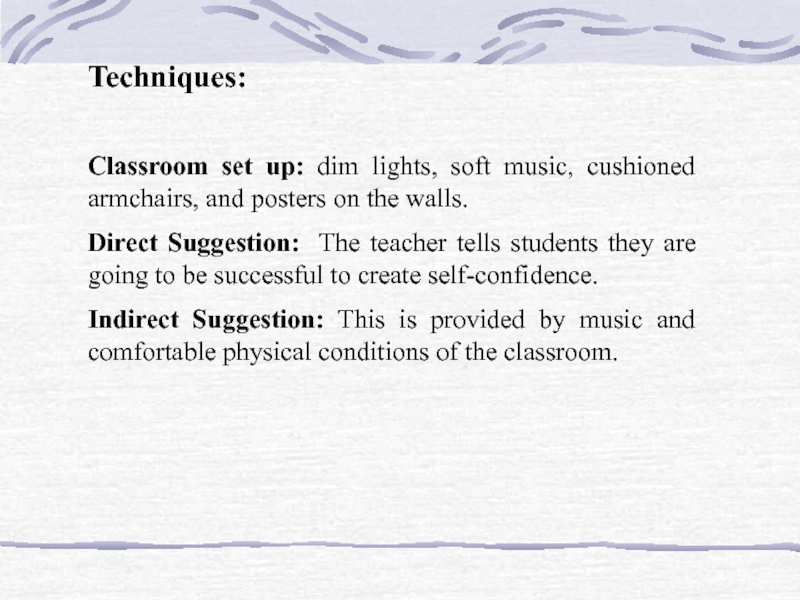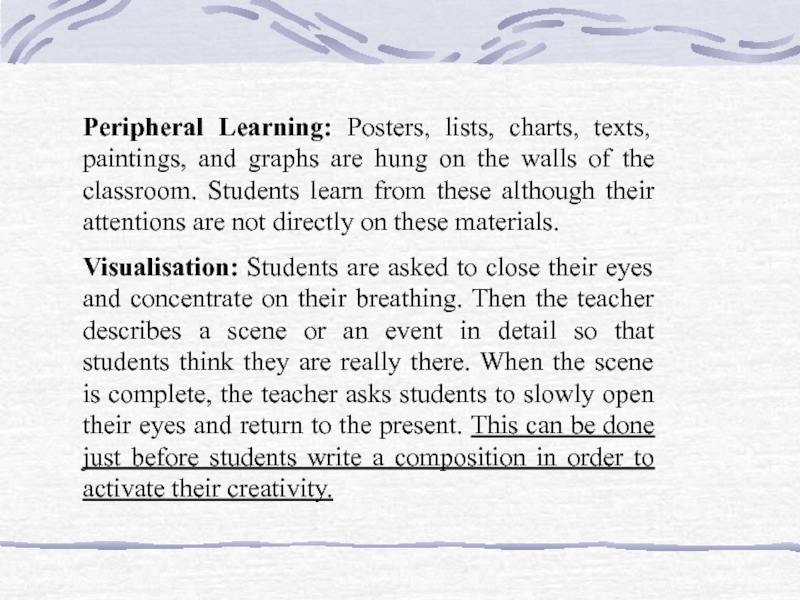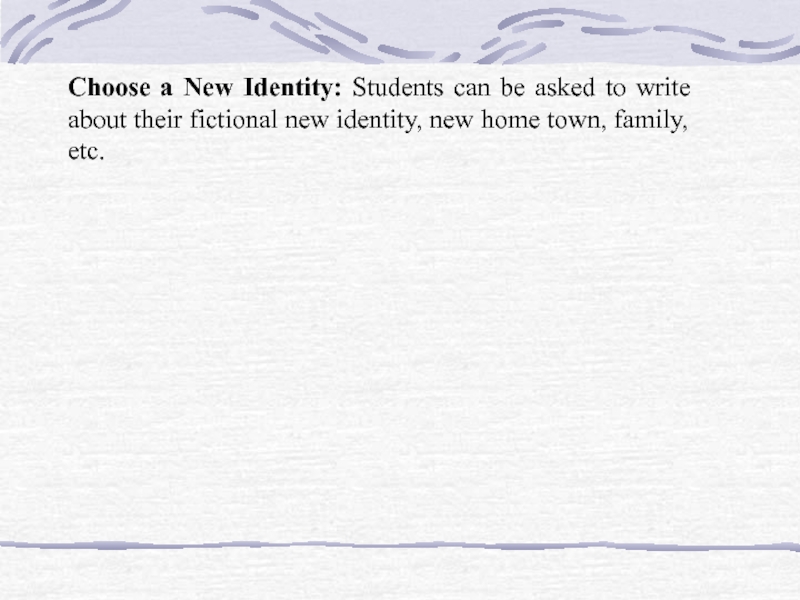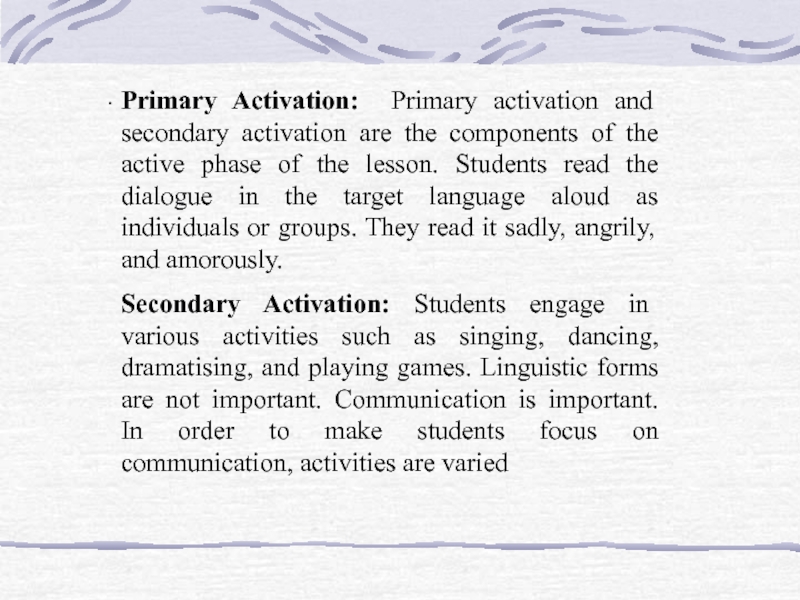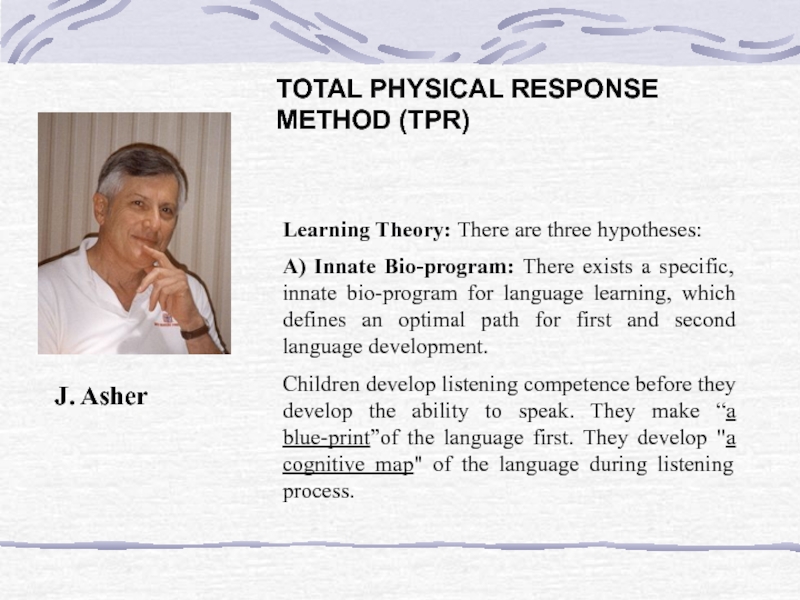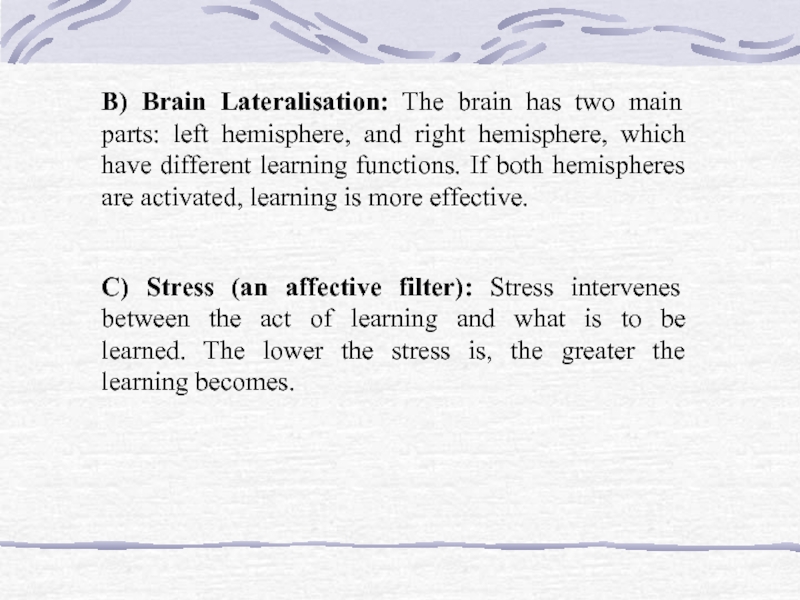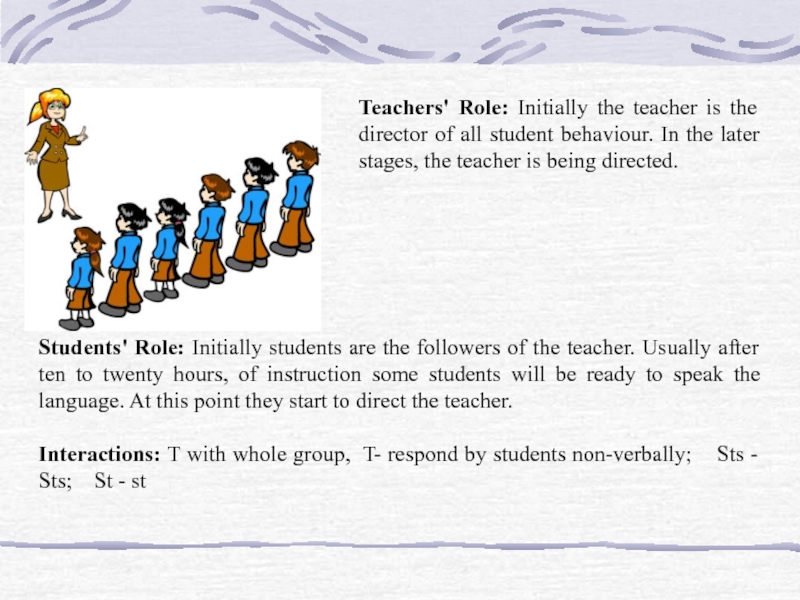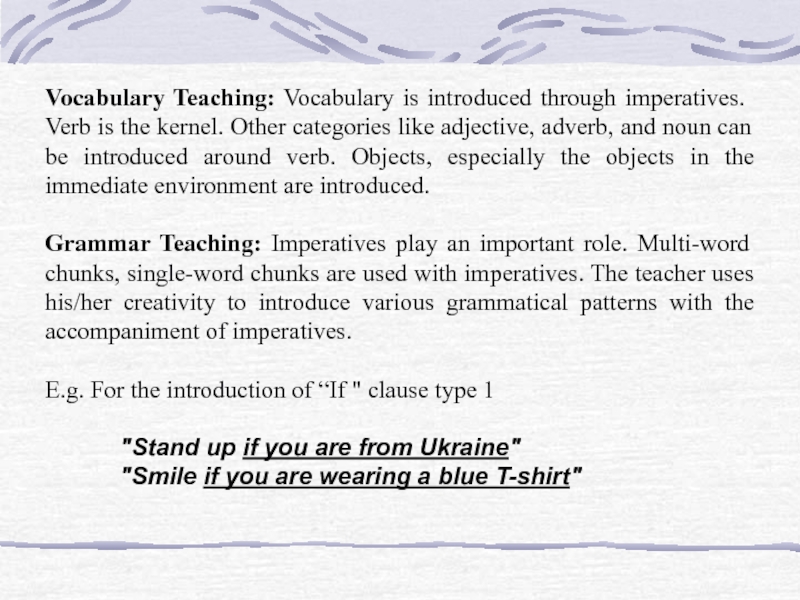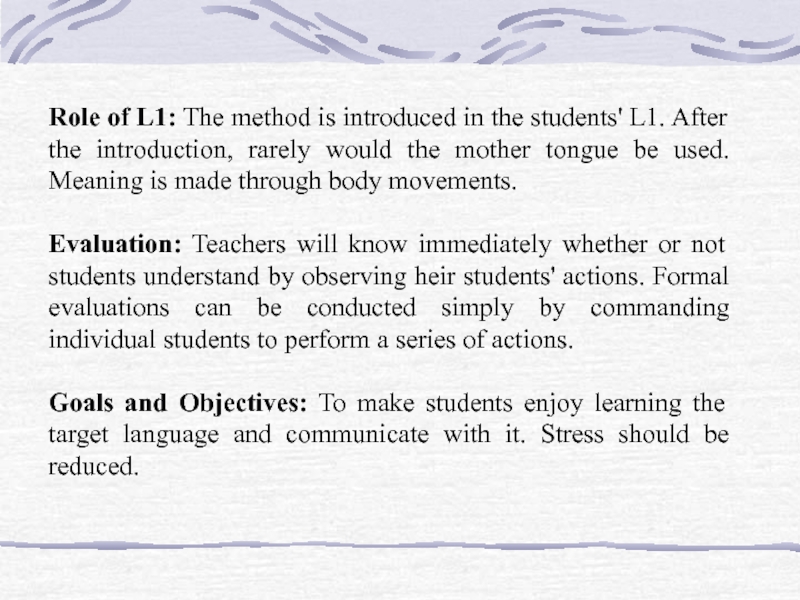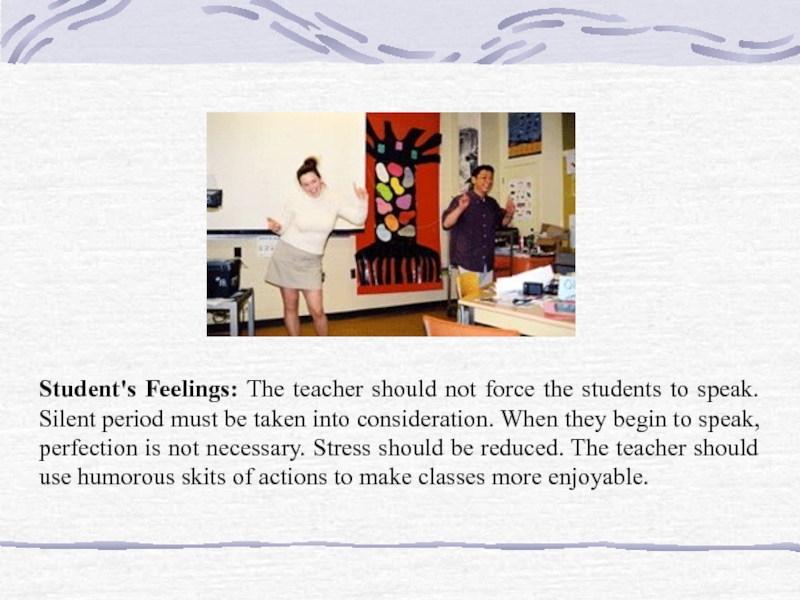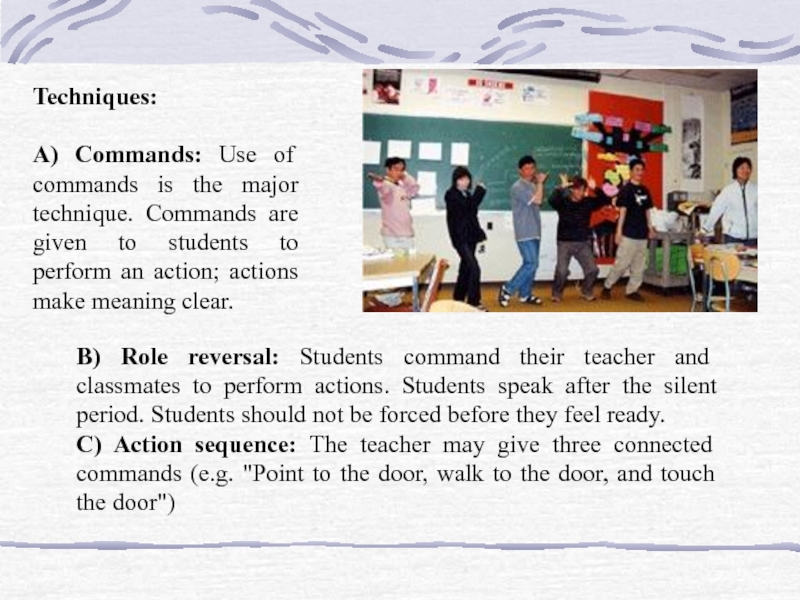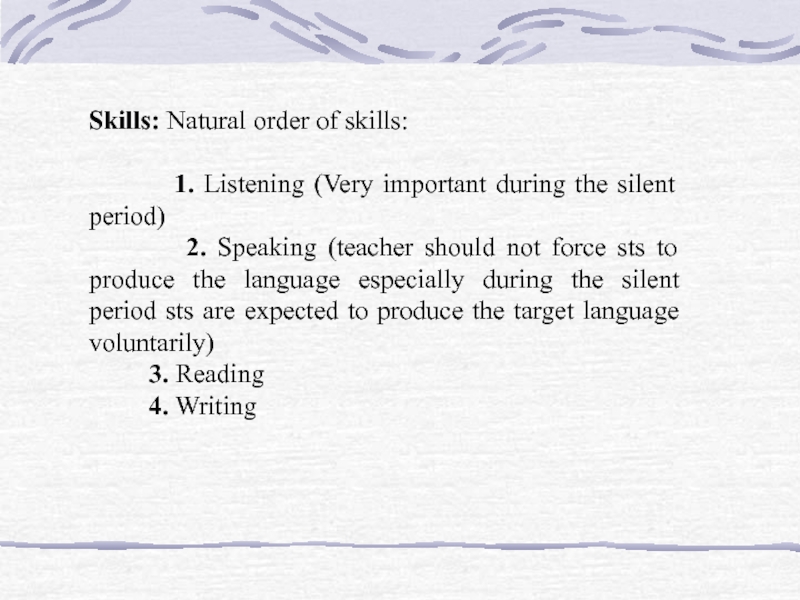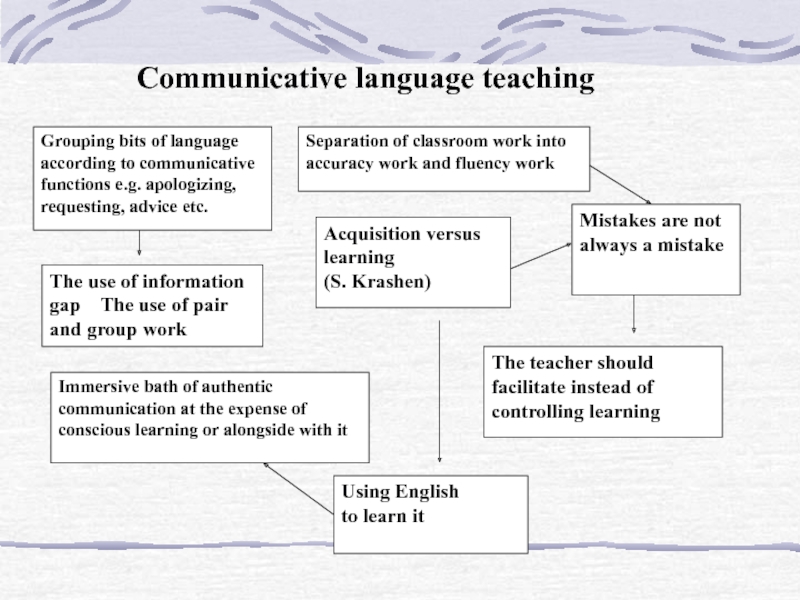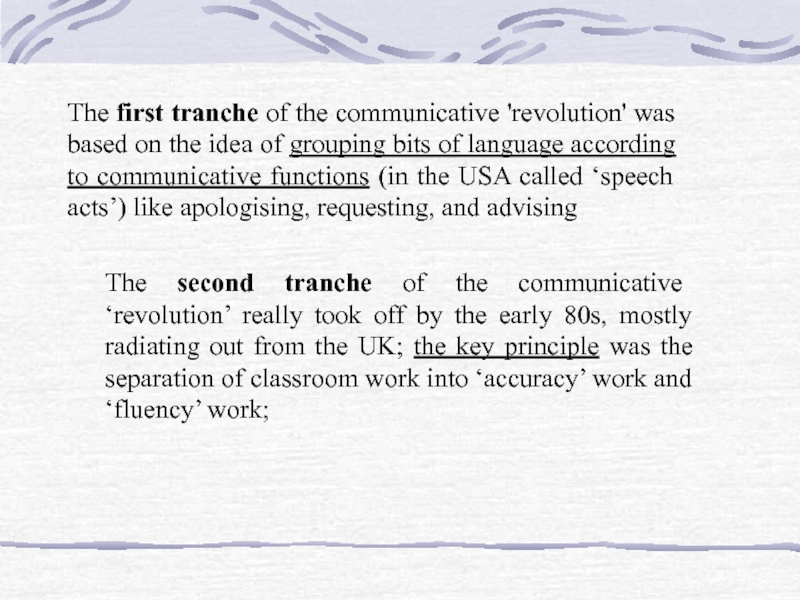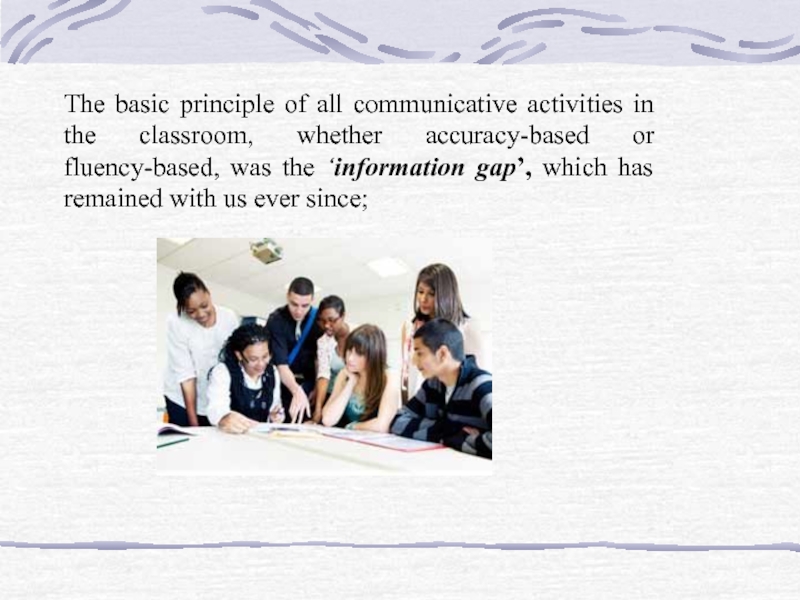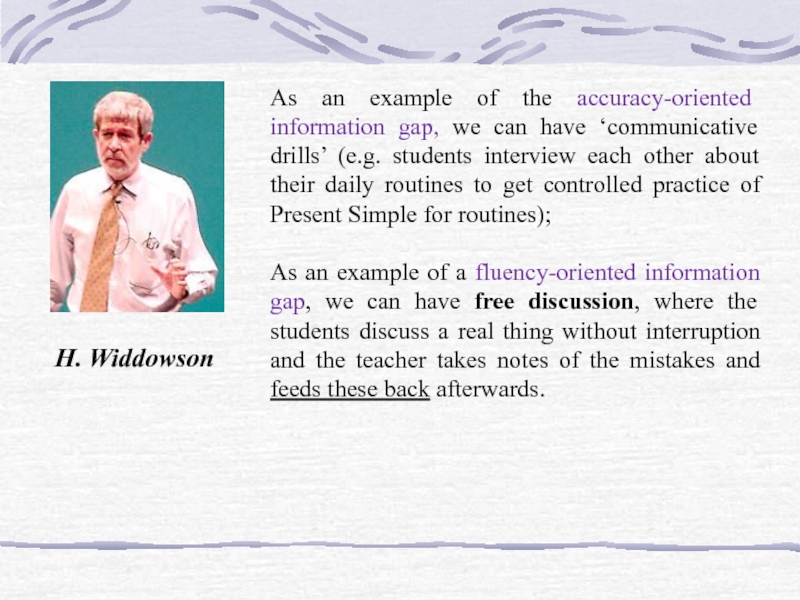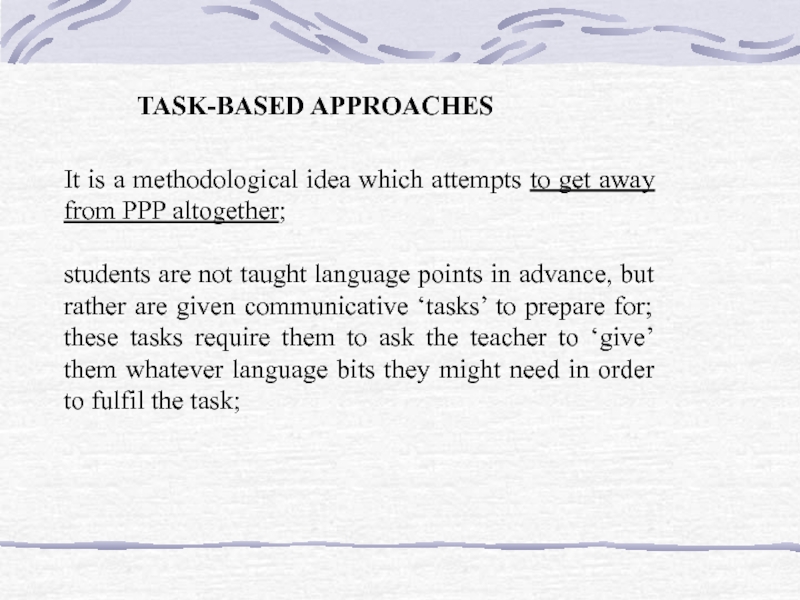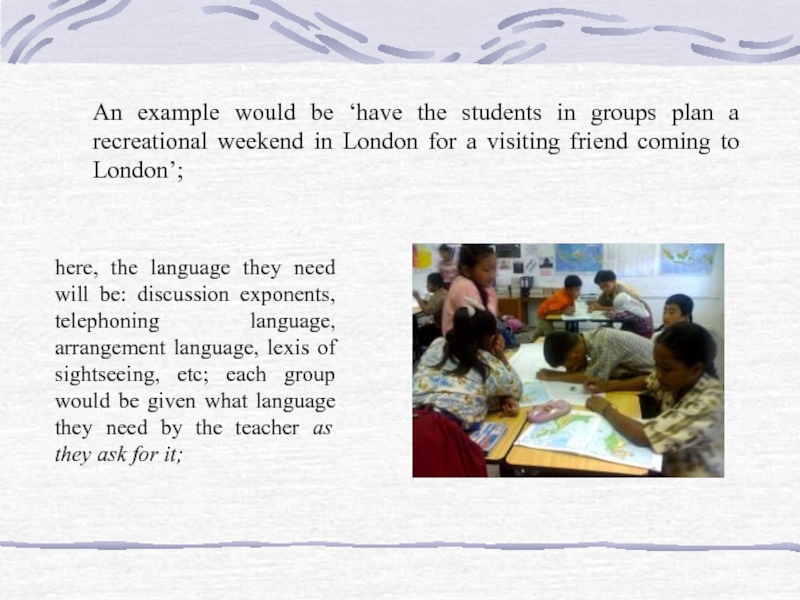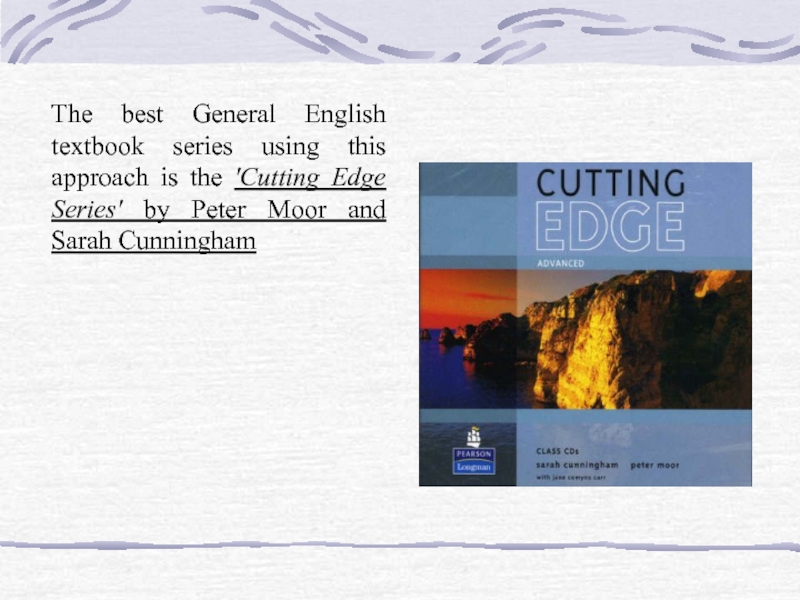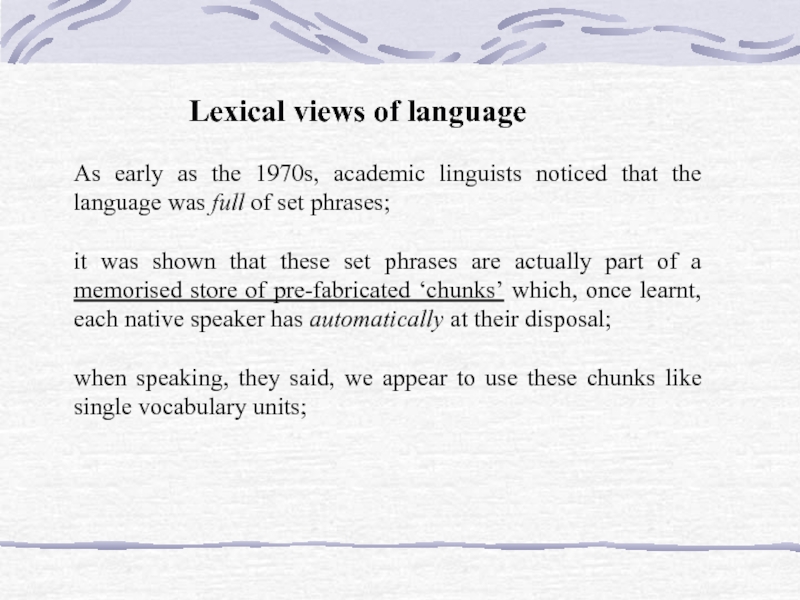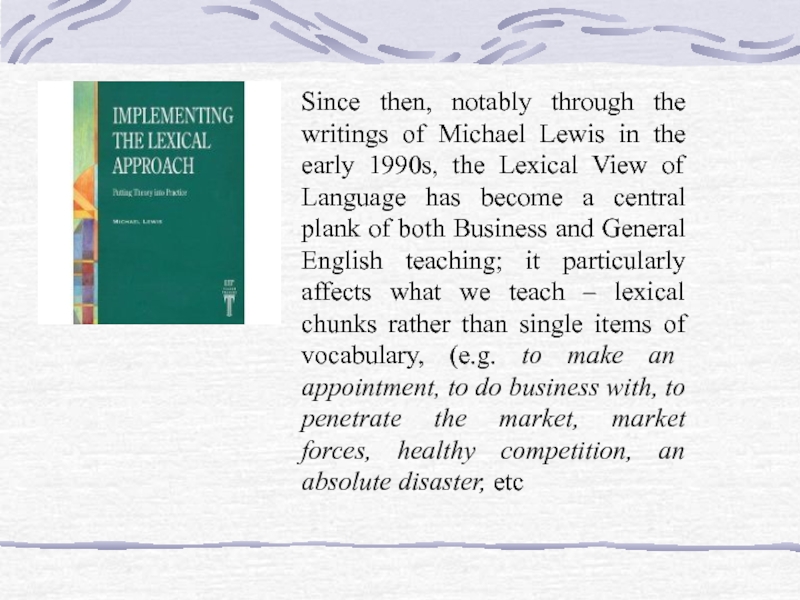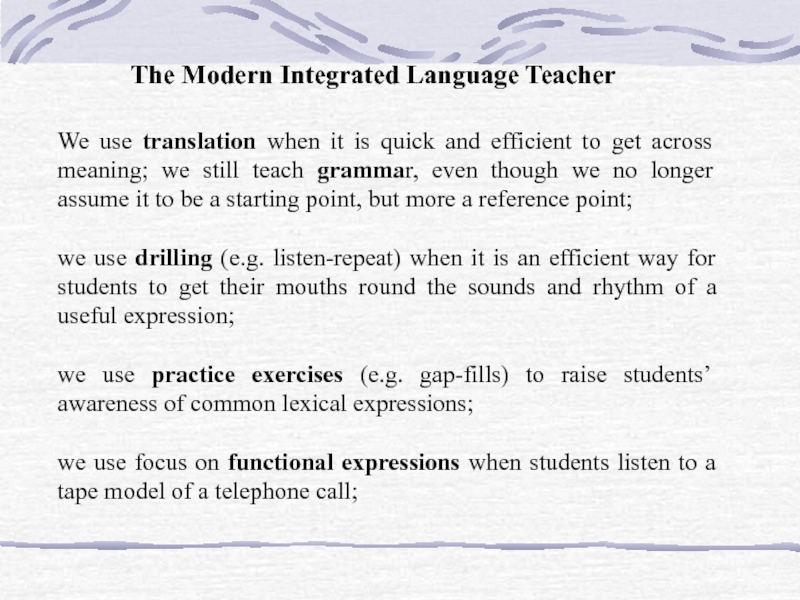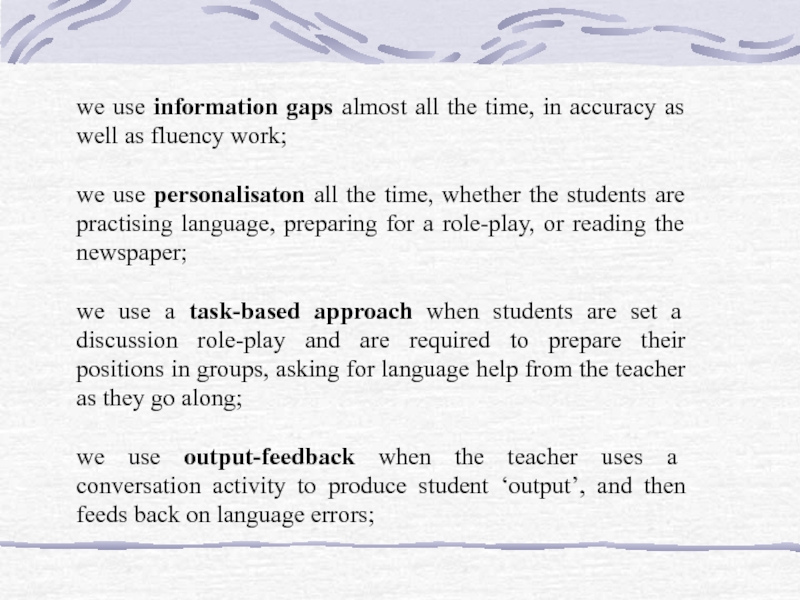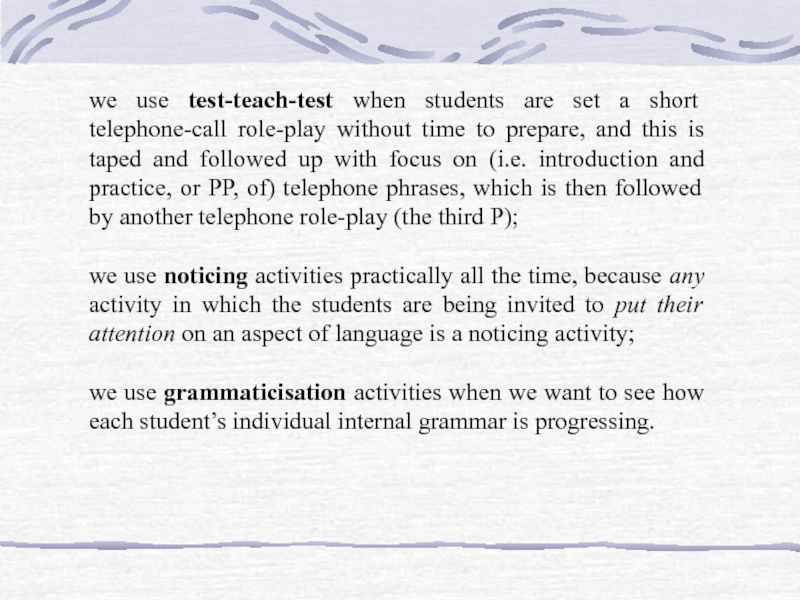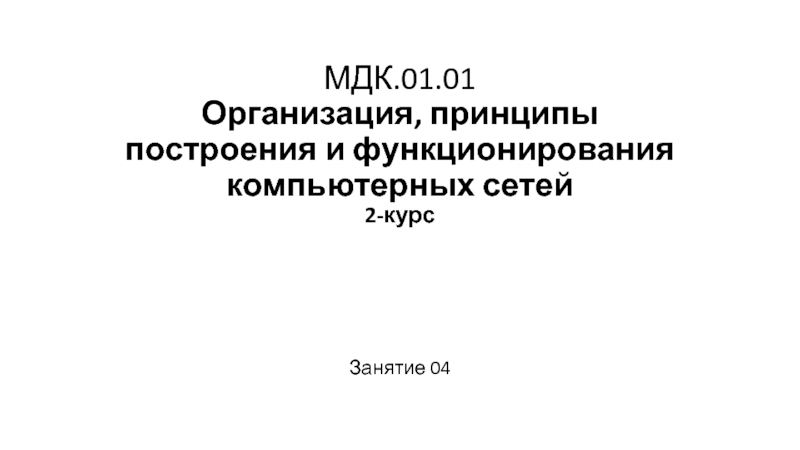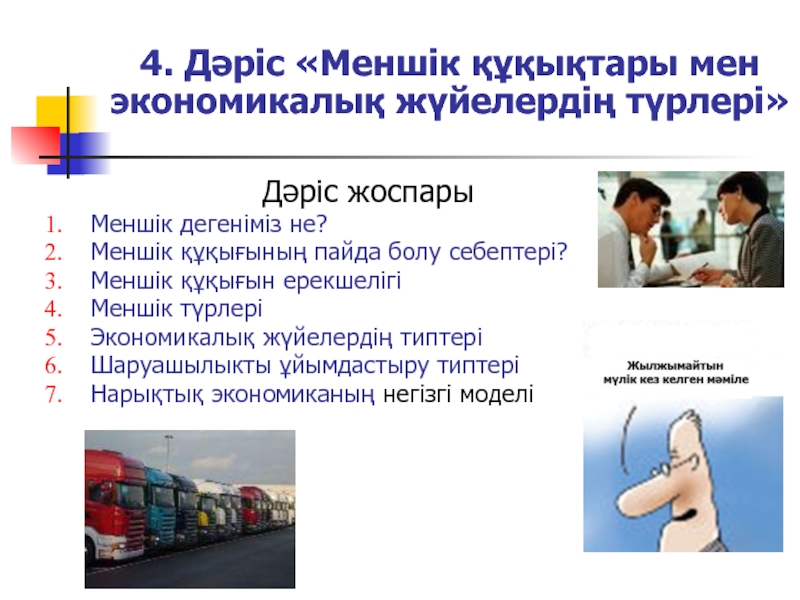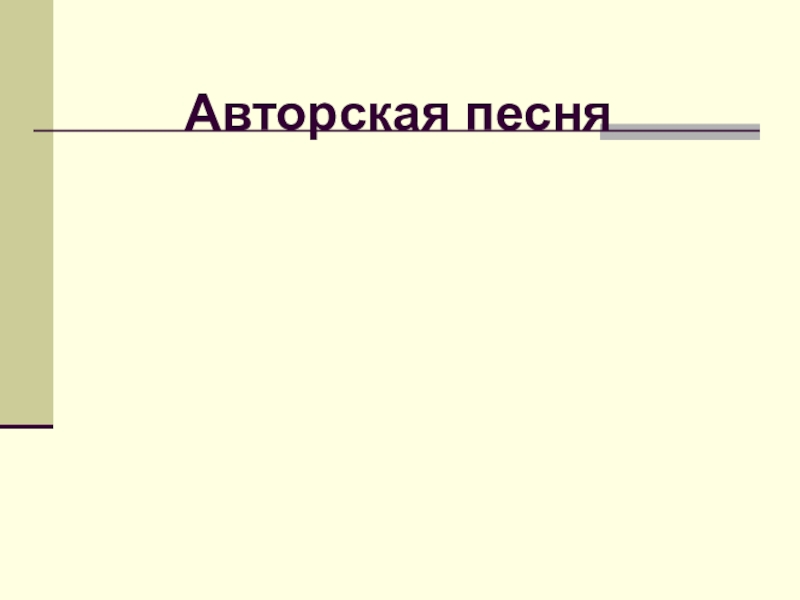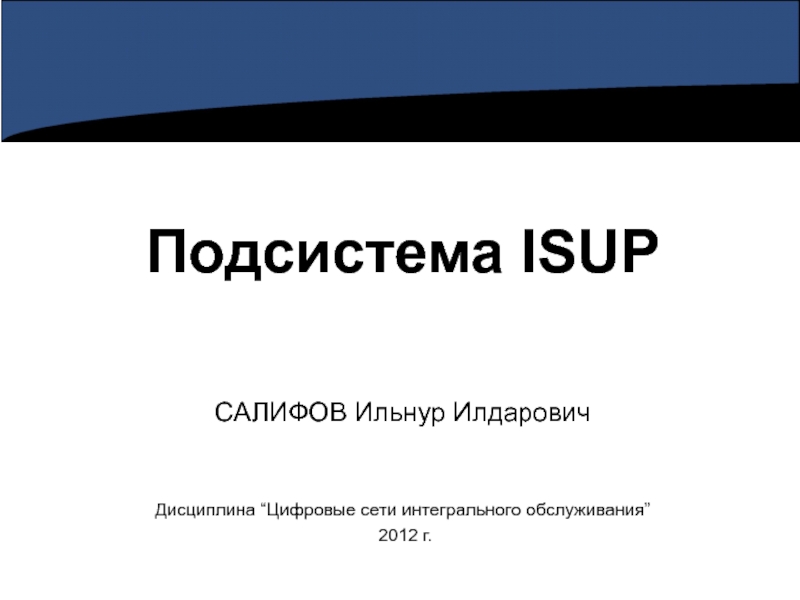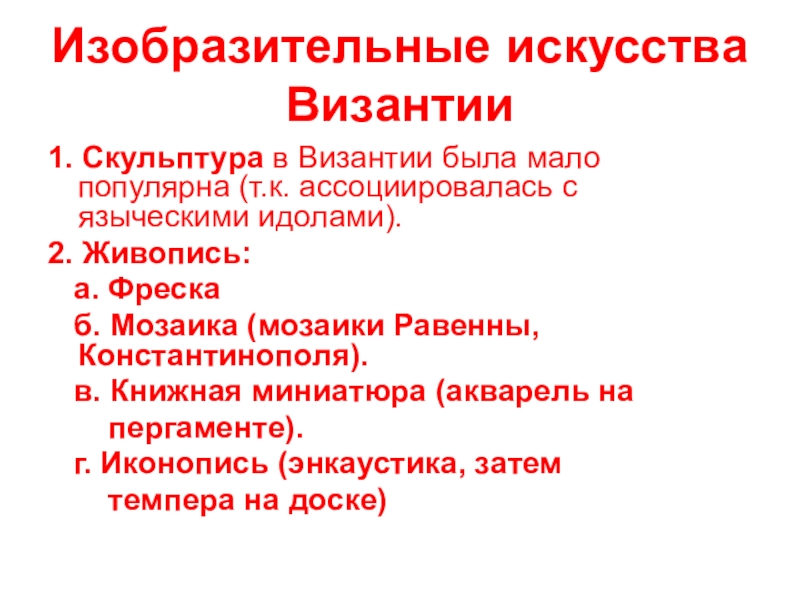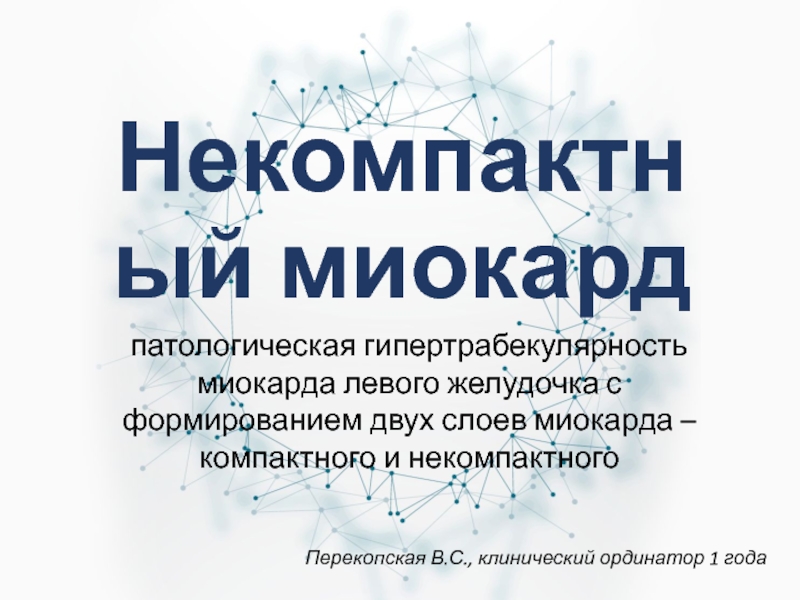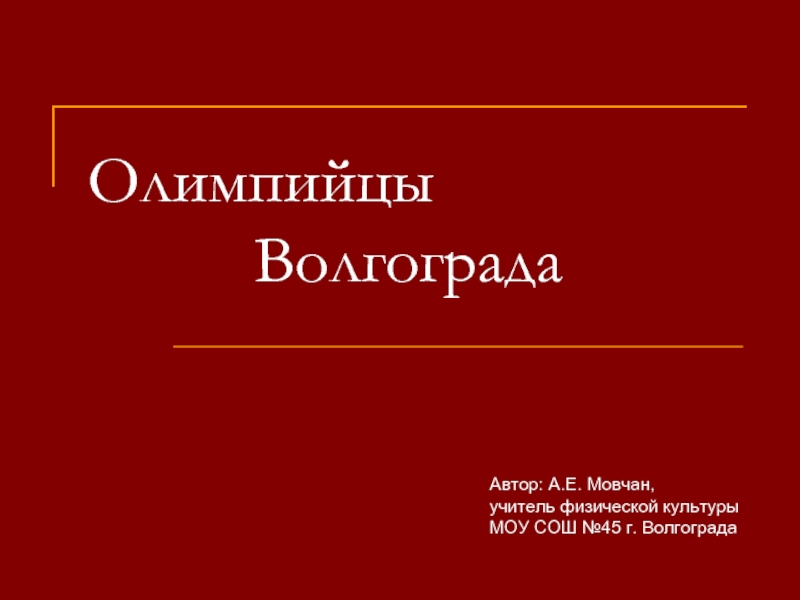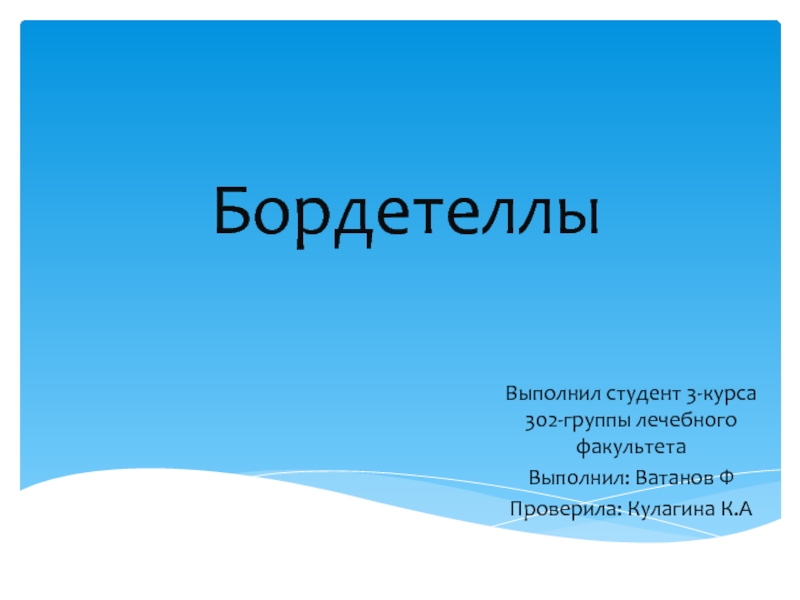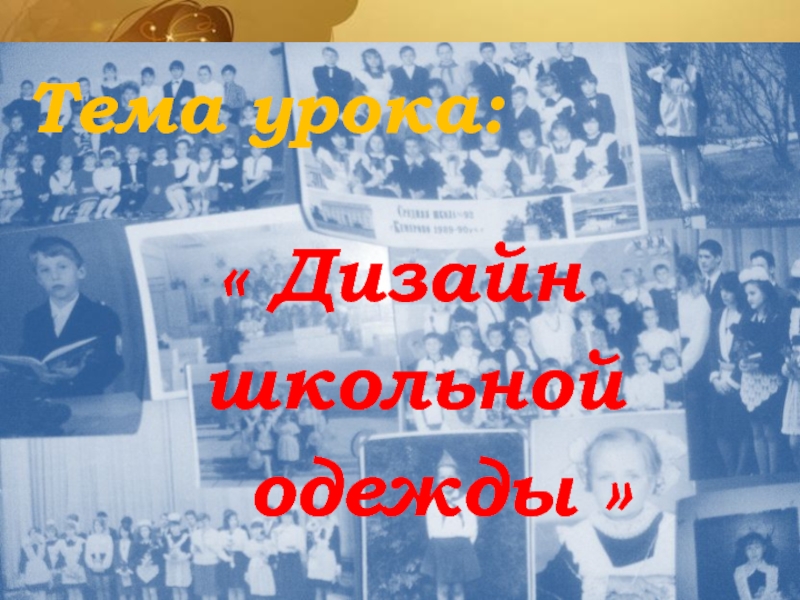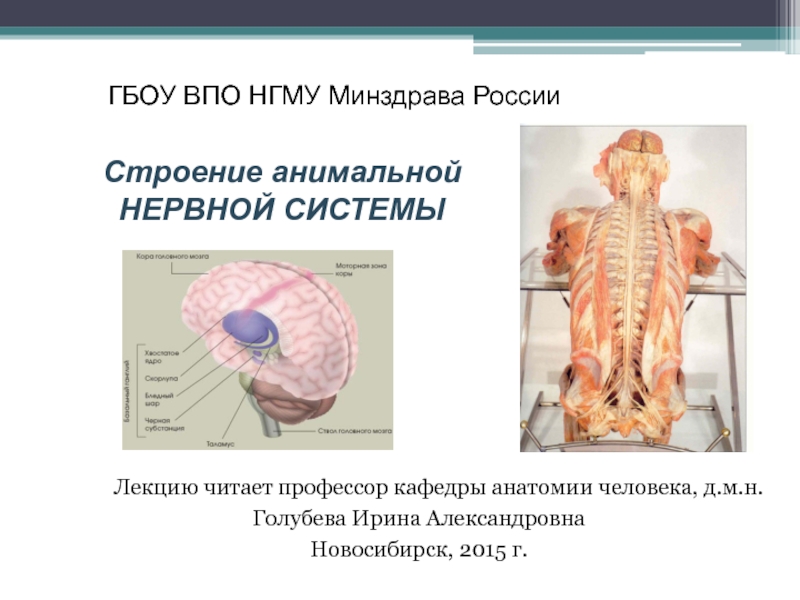Разделы презентаций
- Разное
- Английский язык
- Астрономия
- Алгебра
- Биология
- География
- Геометрия
- Детские презентации
- Информатика
- История
- Литература
- Математика
- Медицина
- Менеджмент
- Музыка
- МХК
- Немецкий язык
- ОБЖ
- Обществознание
- Окружающий мир
- Педагогика
- Русский язык
- Технология
- Физика
- Философия
- Химия
- Шаблоны, картинки для презентаций
- Экология
- Экономика
- Юриспруденция
Methods of teaching English: A brief history
Содержание
- 1. Methods of teaching English: A brief history
- 2. Google, booksPart 2. Section 2
- 3. Why do we need to learn about
- 4. The concerns that have prompted modern method
- 5. Many current issues of language teaching are
- 6. Particular methods differ in the way they address key issues. These issues are as follows:
- 7. What should the goals of the language
- 8. 5. What should the role of the
- 9. We integrate or take into account past approaches rather than sweep them away.
- 10. The early applied linguists such as Henry
- 11. 1850s – 1950s: Grammar Translation method
- 12. Learning Theory: Deductive learning is essential:
- 13. Teachers' Role: Teacher is the strict authority.
- 14. Vocabulary Teaching: The most common vocabulary teaching
- 15. Grammar Teaching: The teaching of grammar is
- 16. Materials: Texts from the target language literature
- 17. Goals and Objectives: Among the goals are
- 18. Techniques1. Translation of a Literary Passage: Students
- 19. First, they answer information questions whose answers
- 20. 3. Antonyms / Synonyms: Students are given
- 21. 6. Memorisation: Students are given lists of
- 22. General overview: - grammar was taught
- 23. - written text was seen as the
- 24. Which of the techniques and principles of
- 25. 1890s – now: Direct Method
- 26. Behaviourism: learning as habit formationThe first coherent
- 27. Learning Theory: Inductive learning is essential. There
- 28. Teacher's Role: The teacher usually directs the
- 29. Vocabulary Teaching: Pictures, realia, examples, sample sentences
- 30. Role of L1: L1 is not permitted.Evaluation:
- 31. Skills: Speaking, listening, reading and writing are
- 32. General overview: - speaking and listening were
- 33. - vocabulary was learnt either incidentally, as
- 34. Слайд 34
- 35. Francois Gouin. Learning a language the wrong wayhttp://hubpages.com/hub/Language-Learning-Methods-Scams-lies-and
- 36. The Direct method was quite successful in
- 37. 1. It was difficult to implement in public secondary school education. !!!
- 38. 2. It overemphasized and distorted the similarities
- 39. 3. It lacked a basis in applied
- 40. Which of the techniques and activities suggested
- 41. Audio-lingual method + Structuralist view of
- 42. Learning Theory: Learning is based on the
- 43. There is a natural order of skills.
- 44. Teacher’s Role: T is like an orchestra
- 45. Interactions: T-St, ST- ST. Interactions are mostly
- 46. Role of L1: L1 is not allowed
- 47. Skills: Listening and speaking are emphasised. There
- 48. - vocabulary was seen as an adjunct
- 49. - automaticity of response was favoured; -
- 50. Various kinds of drillsRepetition. The student repeats
- 51. 2. Infections. One word in an utterance
- 52. 3. Restatement. The students rephrases an utterance
- 53. 5. Integration. Two separate utterances are integrated
- 54. 7. Restoration. The students is given the
- 55. 1960s –1980s (UK): Structural-situational method (PPP) This was
- 56. this approach gave rise to the idea
- 57. it was assumed that what we taught
- 58. 1970s – 1980s: Humanistic approaches Silent Way, Total Physical Response, Suggestopedia etc.
- 59. Why humanistic?
- 60. Behaviourism: learning as habit formation Mentalism: thinking
- 61. THE SILENT WAY (SW) (Caleb Gattegno)Learning Theory:
- 62. Teachers' Role: The teacher is a technician
- 63. Students' Role: Students should make use of
- 64. Vocabulary Teaching: Vocabulary is taught by means
- 65. Слайд 65
- 66. Слайд 66
- 67. Слайд 67
- 68. Role of L1: L1 can be used
- 69. Goals and Objectives: Students should be able
- 70. Techniques:1.Teaching pronunciation with "sound colour charts"2. Cognitive
- 71. Слайд 71
- 72. 6. Structured feedback: Students are invited to
- 73. Learning Theory: People use 5-10% of their
- 74. Six principle theoretical components through which desuggestion
- 75. 4). Varying intonation of the presented material
- 76. 2. Teachers' Role: Teacher is the authority. Learners
- 77. 6. Grammar Teaching: Grammar is taught explicitly
- 78. 8. Goals and Objectives: Teachers hope to
- 79. 10. Student's Feelings: A great deal of
- 80. Techniques: Classroom set up: dim lights, soft
- 81. Peripheral Learning: Posters, lists, charts, texts, paintings,
- 82. Choose a New Identity: Students can be
- 83. . Primary Activation: Primary activation and secondary
- 84. TOTAL PHYSICAL RESPONSE METHOD (TPR)Learning Theory: There
- 85. B) Brain Lateralisation: The brain has two
- 86. Teachers' Role: Initially the teacher is the
- 87. Vocabulary Teaching: Vocabulary is introduced through imperatives.
- 88. Role of L1: The method is introduced
- 89. Student's Feelings: The teacher should not force
- 90. Techniques:A) Commands: Use of commands is the
- 91. Skills: Natural order of skills:
- 92. Communicative language teaching
- 93. The first tranche of the communicative 'revolution'
- 94. The basic principle of all communicative activities
- 95. As an example of the accuracy-oriented information
- 96. Task-based approachesIt is a methodological idea which
- 97. An example would be ‘have the students
- 98. The best General English textbook series using
- 99. Lexical views of language As early as
- 100. Since then, notably through the writings of
- 101. The Modern Integrated Language TeacherWe use translation
- 102. we use information gaps almost all the
- 103. we use test-teach-test when students are set
- 104. Скачать презентанцию
Слайды и текст этой презентации
Слайд 3Why do we need to learn about the methods of
teaching English which were popular in the past?
Слайд 4The concerns that have prompted modern method innovations were similar
to those that have always been at the centre of
discussions on how to teach foreign languages.In the past some of the questions were raised that prompted innovations and new directions in ELT
Слайд 5Many current issues of language teaching are not particularly new
!!! Today’s controversies reflect contemporary responses to questions that have been
asked often throughout the history of ELT.Слайд 7What should the goals of the language teaching be? Should
a language course try to teach conversational proficiency, reading, translation,
or some other skill?What is the basic nature of language? How will it effect a teaching method?
What are the principles for the selection of language content in language teaching?
What principles of organisation, sequencing, and presentation best facilitate learning?
Слайд 85. What should the role of the native language be?
6.
What processes do learners use in mastering a language, and
can these be incorporated into a method?7. What teaching techniques and activities work best and under what circumstances?
Слайд 10The early applied linguists such as Henry Sweet (1845-1912), Otto
Jespersen (1860-1943), and Harold Palmer (1877-1949) elaborated principles and theoretically
accountable approaches to the design of language teaching programmes, courses and materialsHarold Palmer
Слайд 12 Learning Theory: Deductive learning is essential: First, the teacher
gives rules explicitly then the rules are reinforced with examples
and exercises.Language Theory:
Translation is the way to learn the language.
Oral communication is not primarily important. Written language is superior to spoken language.
Students also learn the structure of their own native language.
Those who study a foreign language become more cultured and intellectual.
Слайд 13Teachers' Role: Teacher is the strict authority. Classes are teacher-centred.
Students'
Role: Students are the passive receivers of the new information.
The teacher starts the activities and directs them. Students are supposed to memorise the rules and the new vocabulary with their meanings in their native language.Interactions: Very often “Teacher –Student” interactions occur. Rarely “Student – Student” interactions occur.
Слайд 14Vocabulary Teaching: The most common vocabulary teaching technique is “the
memorisation of long lists of vocabulary with their equivalents in
the students’ native language.Слайд 15Grammar Teaching: The teaching of grammar is deductive. The teacher
introduces the rules explicitly and wants the students to apply
these rules to new examples in exercises.Students are supposed to memorise the rules. In order to explain the rules, the teacher uses comparison and contrast between the students’ native language grammar and target language grammar.
Translation is a common way to clarify the meanings of the new grammar patterns in the target language.
Слайд 16Materials: Texts from the target language literature are used. The
teacher may either write the text or use an authentic
literary text.Role of L1: L1 (i.e., students’ native language) has an important function in teaching vocabulary and grammar. Since oral communication in the target language is not important, classroom instructions are given in L1.
Слайд 17Goals and Objectives: Among the goals are to teach translation,
to read and understand literary texts in the target language,
to make students aware of their native language structure and vocabulary, and to improve students’ mental capacities with grammar exercises.Error Correction: The teacher corrects the errors strictly. Errors are not tolerated. Accuracy is emphasised strictly. Accuracy means grammatical correctness.
Student's Feelings: There is no information about how GTM deals with students’ feelings.
Слайд 18Techniques
1. Translation of a Literary Passage: Students translate a passage
from the target language into their native language. The passage
provides the focus for several classes: vocabulary and grammatical structures in the passage are studied in the following lessons.2. Reading Comprehension Questions: Students answer questions in the target language based on their understanding of the reading passage.
Слайд 19First, they answer information questions whose answers they can find
in the passage.
Second, they answer inference questions based on
their comprehension of the passage although the answer cannot be found in the passage directly in the passage. Third !!!, they answer questions that require students to relate the passage to their own experience.
Слайд 203. Antonyms / Synonyms: Students are given one set of
words and are asked to find antonyms in the reading
passage. A similar exercise could be done by asking students to find synonyms for a particular set of words.4. Deductive Application of Rule: Grammar rules are presented with examples. Exceptions to each rule are also noted. Once students understand a rule, they are asked to apply it to some different examples.
5. Fill-in-the blanks: Students are given a series of sentences with words missing. They fill in the blanks with new vocabulary items or necessary items of grammatical features
Слайд 216. Memorisation: Students are given lists of target language vocabulary
words and their native language equivalents and are asked to
memorise them. Students are also required to memorise grammatical rules and grammatical paradigms such as verb conjugations.7. Use words in Sentences: In order to show that students understand the meaning and use of a new vocabulary item, they make up sentences in which they use the new words.
8. Composition: The teacher gives the students a topic to write about in the target language. The topic is based upon some aspect of the reading passage of the lesson.
Слайд 22General overview:
- grammar was taught as a set of rules
(e.g. verb conjugations) after the classical languages, Latin and
Greek;- practice was done through written exercises;
- the medium of instruction was the mother tongue;
- vocabulary was learnt via translated lists, often related to the comprehension of written texts;
Слайд 23- written text was seen as the ‘real’ language, superior
to the spoken version;
- written texts were translated and
composition in L2 was regarded as the apex of language ability; - speaking and listening were seen as less important, and mediated via ‘conversation classes’ which were tagged on as extras to the main course.
Слайд 24Which of the techniques and principles of GTM do we
still use in the modern language teaching?
Слайд 26Behaviourism: learning as habit formation
The first coherent theory of learning
was the behaviourist theory based mainly on the work of
Pavlov in the Soviet Union and of Skinner in the United States. This simple but powerful theory said that learning is a mechanical process of habit formation and proceeds by means of the frequent reinforcement of a stimulus-response sequence. The theory provided the theoretical underpinning of the widely used Direct Method.Слайд 27Learning Theory: Inductive learning is essential. There is a direct
relation between form and meaning. L2 learning is similar to
L1 acquisition. There is a direct exposure to the target language. Exposure of long chunks in the target language. Learning occurs naturally.Language Theory: Language is for oral use. Each language is unique. There is a direct relation between form and meaning. No other language should interfere when learning a language.
Culture: Not only art or literature, but also other aspects of culture (namely, life style, customs, traditions, institutions, food, daily habits, history, geography, etc.) should be taken into consideration. Daily speech is important.
Слайд 28Teacher's Role: The teacher usually directs the interactions but he/she
is not as dominant as in GTM. Sometimes acts like
a partner of the students.Students' Role: Students are active participants. Sometimes pair works take place. Even the teacher takes roles in activities.
Interactions: T- st and St - st interactions often occur.
Слайд 29Vocabulary Teaching: Pictures, realia, examples, sample sentences are used to
teach vocabulary. The use of L1 is not allowed. There
is a direct relation between form and meaning.Grammar Teaching: Grammar is taught inductively. Examples and drills are given and students are expected to discover and acquire the rules. Drills like chain drill, yes question, no question, or question are used to help students induce the rule.
Materials: Reading passages (for topics), Dialogues (for situation), plays (for situations) are used.
Слайд 30Role of L1: L1 is not permitted.
Evaluation: Sts' ability to
use the language is tested. Not about language, the language
itselfGoals and Objectives: Teaching Sts how to communicate in the target language. Teaching of thinking in the target language.
Error Correction: Sts' self correction.
Students’ Feelings: There is no information dealing with this issue.
Слайд 31
Skills: Speaking, listening, reading and writing are important skills. Especially
speaking and listening are emphasised. Vocabulary is over grammar.
Techniques: Reading
aloud, Question and answer exercise, self-correction, conversation practice, fill-in-the-blank exercise, dictation, drawing (for listening comprehension), and paragraph writing. Слайд 32General overview:
- speaking and listening were the most important
skills;
- the medium of instruction was English;
- students
learnt sequences of strictly-chosen (i.e centrally-scripted) grammatical phrases by listening and repetition;- grammar ‘rules’ were avoided, and replaced by phrases (which of course had grammar disguised in them);
Слайд 33- vocabulary was learnt either incidentally, as part of the
phrases being taught, or via lists grouped under types of
situation;its modern incarnation survives in the omnipresent language phrasebooks, and the method is still the basis of lower-level teaching in Berlitz’s successful language schools.
Слайд 35Francois Gouin. Learning a language the wrong way
http://hubpages.com/hub/Language-Learning-Methods-Scams-lies-and
Слайд 36The Direct method was quite successful in private language schools,
such as those of the Berlitz chain, where paying clients
had high motivation and the use of native speakers was the norm.Слайд 382. It overemphasized and distorted the similarities between naturalistic first
language learning and classroom foreign language learning
It failed to
consider the practical realities of the classroom.Слайд 393. It lacked a basis in applied linguistic theory, and
for this reason it was often criticised by the more
academically based proponents of the Reform Movement.Слайд 40Which of the techniques and activities suggested by the Direct
Method do we use in the modern teaching practice?
Слайд 41Audio-lingual method +
Structuralist view of language
A ‘scientificised’ version of
the direct method; the new science of linguistics suggested that
language was a set of ‘structures’‘this shirt needs + washing, mending, ironing’; ‘he has + washed, ironed, folded, etc the clothes’);
grammar rules were an illusion, so it was more important to focus on these ‘structures’;
Слайд 42Learning Theory: Learning is based on the principles of Behaviourism.
Habit Formation is essential. Rules are induced from examples. Explicit
grammar rules are not given. Learning is inductive. Habit formation is actualised by means of repetitions and other mechanical drills.Language Theory: Language is based on descriptive linguistics. Every language is seen as its own unique system. The system is comprised of several different levels. (i.e. phonological, morphological, and syntactic).
Слайд 43There is a natural order of skills. 1. Listening, 2.
Speaking,
3. Reading,
4. Writing.
Language is primarily for Oral
Communication !!! Слайд 44Teacher’s Role: T is like an orchestra leader. S/he directs
and controls the language behaviour of the students. T is
a good model of the target language, especially for pronunciation and other oral skills. The differences between Sts’ L1 and L2 should be known by the teacher.Students’ Role: Sts are imitators of the teacher as perfect model of the target language or the native speakers in the audio recordings.
Слайд 45Interactions: T-St, ST- ST. Interactions are mostly initiated by the
teacher.
Vocabulary Teaching: Meaning is taught directly. L1 is prohibited
because it may cause bad habit formations. Vocabulary is introduced through dialogues.Grammar Teaching: Explicit rules are not provided. Students induce the rules through examples and drills. Students acquire grammar by being exposed to patterns through mechanical drills.
Materials: Dialogues
Слайд 46Role of L1: L1 is not allowed in the classroom.
It may cause interference and bad habit formation in L2.
Goals
and Objectives: to enable students to speak and write in the target language. To make students able to use the target language automatically without stopping to think. To form new habits in the target language. Слайд 47Skills: Listening and speaking are emphasised. There is a natural
order of skills.
Listening 2. Speaking 3. Reading 4. Writing
Error
Correction: Errors are corrected by the teacher since errors may cause bad habit formation !!!.Sts’ Feelings: There are no principles related to Sts’ feelings
Слайд 48- vocabulary was seen as an adjunct to the structures;
-
speaking and listening were the most important skills;
- the
learning method was based on behaviourist psychology – stimulus-response learning; language exercises for speaking were mostly listen and repeat (i.e. drilling), and repeat and extend; - language exercises for writing were multiple choice and gapfill;
- thinking was discouraged !!!,
.
Слайд 49- automaticity of response was favoured;
- the language laboratory
epitomised the audio-lingual approach and was meant to revolutionise language
teaching – the reason that it did not do so was simply, as with computers nowadays, that most learners need people as teachers, not machines;- a lasting legacy of this approach is the much-loved substitution table
Слайд 50Various kinds of drills
Repetition. The student repeats an utterance aloud
as soon as he has heard it. He does this
without looking at a printed text. After a student has repeated an utterance, he may repeat it again and add a few words, then repeat the whole utterance and add more words. I used to know him. – I used to know him.I used to know him years ago. I used to know him years ago when we were at school.
Слайд 512. Infections. One word in an utterance appears in another
form when repeated. I brought the ticket. – I brought
the tickets. I called the young man. – I called the young men.3. Replacement. One word in an utterance is replaced by another.
He bought this house cheap. – He bought it cheap.
Helen left early. - She left early.
Слайд 523. Restatement. The students rephrases an utterance and addresses it
to someone else, according to instructions.
Tell him to wait
for you. – Wait for me.
Ask her how old she is. - How old are you? 4. Completion. The students hears an utterance that is complete except for one word, then repeats an utterance in completed form.
I’ll go my way and you go … I’ll go my way and you go yours.
Слайд 535. Integration. Two separate utterances are integrated into one. They
must be honest. This is important. - It is important
that they (should) be honest.6. Transformation. A sentence is transformed by being made negative or interrogative or thorough changes in tense, mood, voice, aspect etc.
He knows my address. – He doesn’t know my address.
Слайд 547. Restoration. The students is given the sequence of words
that have been picked out from a sentence but still
bear its basic meaning. He uses these words to restore the sentences. He may be told whether the tense is past, present or future.Students/waiting/bus – The students are waiting for the bus.
8. Rejoinder. The student makes an appropriate rejoinder to a given utterance.
Be polite: - Thank you. – You are welcome. - Make I take one? – Certainly.
Слайд 551960s –1980s (UK): Structural-situational method (PPP)
This was a pragmatic (i.e.
UK) version of audio-lingualism; the key difference from the audio-lingual
approach was that the language presentation and practice was situationalised and so was always given social meaning;speaking and listening were the most important skills;
Слайд 56this approach gave rise to the idea of PPP (presentation,
practice, production),
e.g. the Present Simple Tense for routines (called
the target item)was presented (P)
and given controlled practice (P)
and then given further semi-controlled practice (P) (often called ‘free practice’) in, say, a role-play; it all took place in one lesson;
Слайд 57it was assumed that what we taught during these three
stages was what the students should learn,
this equation of
teaching and learning is now seen as a false goalСлайд 581970s – 1980s: Humanistic approaches
Silent Way, Total Physical Response, Suggestopedia
etc.
Слайд 60Behaviourism: learning as habit formation
Mentalism: thinking as rule-governed activity
Cognitive
code: learners as thinking beings
The affective factor: learners as emotional
beingsСлайд 61THE SILENT WAY (SW) (Caleb Gattegno)
Learning Theory: Cognitive Psychology is
the basis. Language learning is not habit formation. It is
rule formation. Language learning has a sequence from the known to the unknown. Students induce the rules from examples and the languages they are exposed to, therefore learning is inductive.Слайд 62Teachers' Role: The teacher is a technician or an engineer
who facilitates learning. Only the learner can do learning. The
teacher is aware of what the students already know and he/she can decide the next step. The teacher is silent. Silence is a tool because teacher's silence gives the responsibility to the student. Besides teacher's silence helps students monitor themselves and improve their own inner criteria.Слайд 63Students' Role: Students should make use of what they already
know. They are responsible for their own learning. They actively
take part in exploring the language. The teacher works with the students and the students work on the language. St-st interaction is important. Sts can learn from each other.Слайд 64
Vocabulary Teaching: Vocabulary is taught by means of visual aids
and word-charts. Vocabulary is always recycled by means of word-charts.
Grammar Teaching: There is a focus on the structures of the language although explicit grammar rules are never given.
Materials: Sound Colour Charts (For teaching pronunciation; one colour represents one sound), Colour Rods (for cognitive coding of grammatical patterns), Fidel Charts (used for sound spelling association.
Слайд 68Role of L1: L1 can be used to give instructions
when necessary. Meaning is made clear by focusing the student's
perceptions, not by translation. During feedback sessions L1 be used at beginning levels.Evaluation: The teacher may never give a formal test. He/she assesses students' learning all the time. Continuous monitoring by the teacher is essential.
Слайд 69Goals and Objectives: Students should be able to use the
target language for self expression (to express their thoughts, feelings,
ideas).Error Correction: Errors are natural and inevitable. The teacher uses students' errors to decide where further work is necessary. Self-correction is necessary for the students to compare their own production with their developing inner criteria.
Слайд 70Techniques:
1.Teaching pronunciation with "sound colour charts"
2. Cognitive coding with colour
rods.
3. Peer correction to improve co-operative manner.
4. Self correction gestures
5.
Teacher's SilenceСлайд 726. Structured feedback: Students are invited to talk about the
day's instruction (what they have learnt that day during classes).
Students learn to take responsibility for their own learning by becoming aware of themselves, and by controlling and applying their own learning strategies.7. Fidel Charts: Used to teach sound spelling association.
8. Word Charts: Used to teach and recycle vocabulary. The words are written in different colours so that students can learn basic pronunciation patterns.
Слайд 73Learning Theory: People use 5-10% of their mental capacity. In
order to make better use of our mental reserves, limitations
need to be desuggested.Suggestopedia. Lozanov method
Students should eliminate the feelings that they cannot be successful and thus, to help them overcome the barriers to learning. Psychological barriers should be removed
Слайд 74Six principle theoretical components through which desuggestion and suggestion operate.
1). People remember best when the new information comes from
a reliable authoritative source. 2). Authority is also used to suggest a teacher-student relation like that of "parent-child" relationship. In the child's role the learner takes part in role-playing, games, songs and gymnastic exercises that help the older student regain the self-confidence, spontaneity and receptivity of the child.
3). The learner learns not only from the instructions but also from the environment. Physical features of the classroom are important.
Слайд 754). Varying intonation of the presented material helps to avoid
boredom. T should present the material with different intonation patterns.
Correct intonation patterns should be emphasised.5). Materials presented with varying rhythm and tones are more interesting.
6). Materials presented with varying rhythm, intonation, and tone should be accompanied by music. Music should have sixty beats in a minute. Baroque concertos work very well for this purpose.
Слайд 762. Teachers' Role: Teacher is the authority. Learners learn better if
they get the information from a reliable authority. Students must
trust and respect that authority.3. Students' Role: Students play a child's role (infantilization). They adopt a new identity (new name, job, family...etc.) As they feel more secure, they can be less inhibited.
4. Interactions: “St-st” and “T-st” interactions occur. Students often do "pair work" and "group work".
Слайд 77
6. Grammar Teaching: Grammar is taught explicitly but minimally. Explicit
grammar rules are provided in L1.
7. Materials: Dialogues are used
with their translations in L1 on the opposite side. Texts with literary value are used. The textbook posters are used for peripheral learning 5. Vocabulary Teaching: Vocabulary is emphasised. Claims about the success of the method often focus on the large number of words that can be acquired. Comments and explanations about the meanings can be provided in student's L1.
Слайд 788. Goals and Objectives: Teachers hope to accelerate the process
by which students learn to use a foreign language for
everyday communication. For this, more of the students' mental power must be employed. This can be achieved by removing psychological barriers.9. Error Correction: At the beginning levels, errors are not corrected immediately because the emphasis is on communication. When errors of form occur, teachers uses the correct form later on during class, because immediate interference by the teacher may destroy the relaxed atmosphere in classes.
Слайд 7910. Student's Feelings: A great deal of attention is given
to students' feelings. Students should feel relaxed and secure. Teacher's
existence and classmates' existence should not threaten the individual. Individual's self-confidence is important.Choice of new identity makes students feel more comfortable and secure. The classroom conditions (temperature, lighting, armchairs) should supply students with the feeling of relaxation and comfort.
Слайд 80Techniques:
Classroom set up: dim lights, soft music, cushioned armchairs,
and posters on the walls.
Direct Suggestion: The teacher tells students
they are going to be successful to create self-confidence. Indirect Suggestion: This is provided by music and comfortable physical conditions of the classroom.
Слайд 81Peripheral Learning: Posters, lists, charts, texts, paintings, and graphs are
hung on the walls of the classroom. Students learn from
these although their attentions are not directly on these materials.Visualisation: Students are asked to close their eyes and concentrate on their breathing. Then the teacher describes a scene or an event in detail so that students think they are really there. When the scene is complete, the teacher asks students to slowly open their eyes and return to the present. This can be done just before students write a composition in order to activate their creativity.
Слайд 82Choose a New Identity: Students can be asked to write
about their fictional new identity, new home town, family, etc.
Слайд 83.
Primary Activation: Primary activation and secondary activation are the
components of the active phase of the lesson. Students read
the dialogue in the target language aloud as individuals or groups. They read it sadly, angrily, and amorously.Secondary Activation: Students engage in various activities such as singing, dancing, dramatising, and playing games. Linguistic forms are not important. Communication is important. In order to make students focus on communication, activities are varied
Слайд 84TOTAL PHYSICAL RESPONSE METHOD (TPR)
Learning Theory: There are three hypotheses:
A)
Innate Bio-program: There exists a specific, innate bio-program for language
learning, which defines an optimal path for first and second language development.Children develop listening competence before they develop the ability to speak. They make “a blue-print”of the language first. They develop "a cognitive map" of the language during listening process.
J. Asher
Слайд 85B) Brain Lateralisation: The brain has two main parts: left
hemisphere, and right hemisphere, which have different learning functions. If
both hemispheres are activated, learning is more effective.C) Stress (an affective filter): Stress intervenes between the act of learning and what is to be learned. The lower the stress is, the greater the learning becomes.
Слайд 86Teachers' Role: Initially the teacher is the director of all
student behaviour. In the later stages, the teacher is being
directed.Students' Role: Initially students are the followers of the teacher. Usually after ten to twenty hours, of instruction some students will be ready to speak the language. At this point they start to direct the teacher.
Interactions: T with whole group, T- respond by students non-verbally; Sts - Sts; St - st
Слайд 87Vocabulary Teaching: Vocabulary is introduced through imperatives. Verb is the
kernel. Other categories like adjective, adverb, and noun can be
introduced around verb. Objects, especially the objects in the immediate environment are introduced.Grammar Teaching: Imperatives play an important role. Multi-word chunks, single-word chunks are used with imperatives. The teacher uses his/her creativity to introduce various grammatical patterns with the accompaniment of imperatives.
E.g. For the introduction of “If " clause type 1
"Stand up if you are from Ukraine" "Smile if you are wearing a blue T-shirt"
Слайд 88Role of L1: The method is introduced in the students'
L1. After the introduction, rarely would the mother tongue be
used. Meaning is made through body movements.Evaluation: Teachers will know immediately whether or not students understand by observing heir students' actions. Formal evaluations can be conducted simply by commanding individual students to perform a series of actions.
Goals and Objectives: To make students enjoy learning the target language and communicate with it. Stress should be reduced.
Слайд 89Student's Feelings: The teacher should not force the students to
speak. Silent period must be taken into consideration. When they
begin to speak, perfection is not necessary. Stress should be reduced. The teacher should use humorous skits of actions to make classes more enjoyable.Слайд 90Techniques:
A) Commands: Use of commands is the major technique. Commands
are given to students to perform an action; actions make
meaning clear.B) Role reversal: Students command their teacher and classmates to perform actions. Students speak after the silent period. Students should not be forced before they feel ready.
C) Action sequence: The teacher may give three connected commands (e.g. "Point to the door, walk to the door, and touch the door")
Слайд 91Skills: Natural order of skills:
1.
Listening (Very important during the silent period)
2. Speaking (teacher should not force sts to produce the language especially during the silent period sts are expected to produce the target language voluntarily)3. Reading
4. Writing
Слайд 93The first tranche of the communicative 'revolution' was based on
the idea of grouping bits of language according to communicative
functions (in the USA called ‘speech acts’) like apologising, requesting, and advisingThe second tranche of the communicative ‘revolution’ really took off by the early 80s, mostly radiating out from the UK; the key principle was the separation of classroom work into ‘accuracy’ work and ‘fluency’ work;
Слайд 94The basic principle of all communicative activities in the classroom,
whether accuracy-based or fluency-based, was the ‘information gap’, which has
remained with us ever since;Слайд 95As an example of the accuracy-oriented information gap, we can
have ‘communicative drills’ (e.g. students interview each other about their
daily routines to get controlled practice of Present Simple for routines);As an example of a fluency-oriented information gap, we can have free discussion, where the students discuss a real thing without interruption and the teacher takes notes of the mistakes and feeds these back afterwards.
H. Widdowson
Слайд 96Task-based approaches
It is a methodological idea which attempts to get
away from PPP altogether;
students are not taught language points
in advance, but rather are given communicative ‘tasks’ to prepare for; these tasks require them to ask the teacher to ‘give’ them whatever language bits they might need in order to fulfil the task; Слайд 97An example would be ‘have the students in groups plan
a recreational weekend in London for a visiting friend coming
to London’;here, the language they need will be: discussion exponents, telephoning language, arrangement language, lexis of sightseeing, etc; each group would be given what language they need by the teacher as they ask for it;
Слайд 98The best General English textbook series using this approach is
the 'Cutting Edge Series' by Peter Moor and Sarah Cunningham
Слайд 99Lexical views of language
As early as the 1970s, academic linguists
noticed that the language was full of set phrases;
it
was shown that these set phrases are actually part of a memorised store of pre-fabricated ‘chunks’ which, once learnt, each native speaker has automatically at their disposal; when speaking, they said, we appear to use these chunks like single vocabulary units;
Слайд 100Since then, notably through the writings of Michael Lewis in
the early 1990s, the Lexical View of Language has become
a central plank of both Business and General English teaching; it particularly affects what we teach – lexical chunks rather than single items of vocabulary, (e.g. to make an appointment, to do business with, to penetrate the market, market forces, healthy competition, an absolute disaster, etcСлайд 101The Modern Integrated Language Teacher
We use translation when it is
quick and efficient to get across meaning; we still teach
grammar, even though we no longer assume it to be a starting point, but more a reference point;we use drilling (e.g. listen-repeat) when it is an efficient way for students to get their mouths round the sounds and rhythm of a useful expression;
we use practice exercises (e.g. gap-fills) to raise students’ awareness of common lexical expressions;
we use focus on functional expressions when students listen to a tape model of a telephone call;
Слайд 102we use information gaps almost all the time, in accuracy
as well as fluency work;
we use personalisaton all the
time, whether the students are practising language, preparing for a role-play, or reading the newspaper; we use a task-based approach when students are set a discussion role-play and are required to prepare their positions in groups, asking for language help from the teacher as they go along;
we use output-feedback when the teacher uses a conversation activity to produce student ‘output’, and then feeds back on language errors;
Слайд 103we use test-teach-test when students are set a short telephone-call
role-play without time to prepare, and this is taped and
followed up with focus on (i.e. introduction and practice, or PP, of) telephone phrases, which is then followed by another telephone role-play (the third P);we use noticing activities practically all the time, because any activity in which the students are being invited to put their attention on an aspect of language is a noticing activity;
we use grammaticisation activities when we want to see how each student’s individual internal grammar is progressing.
